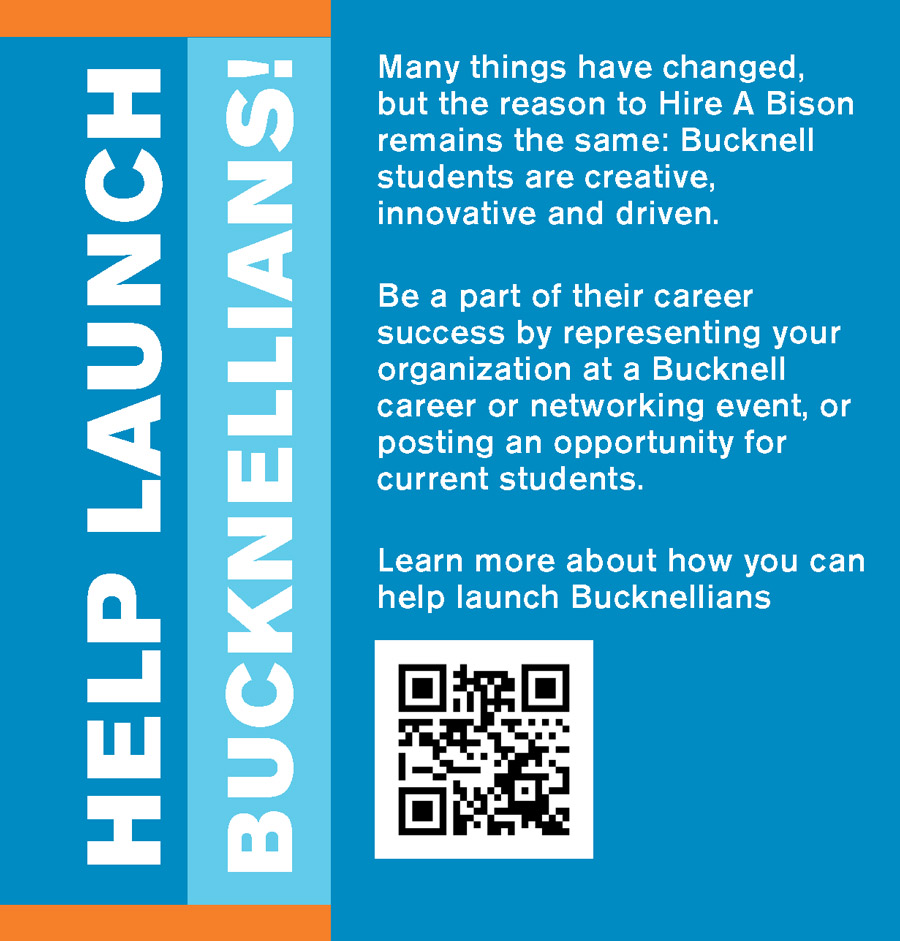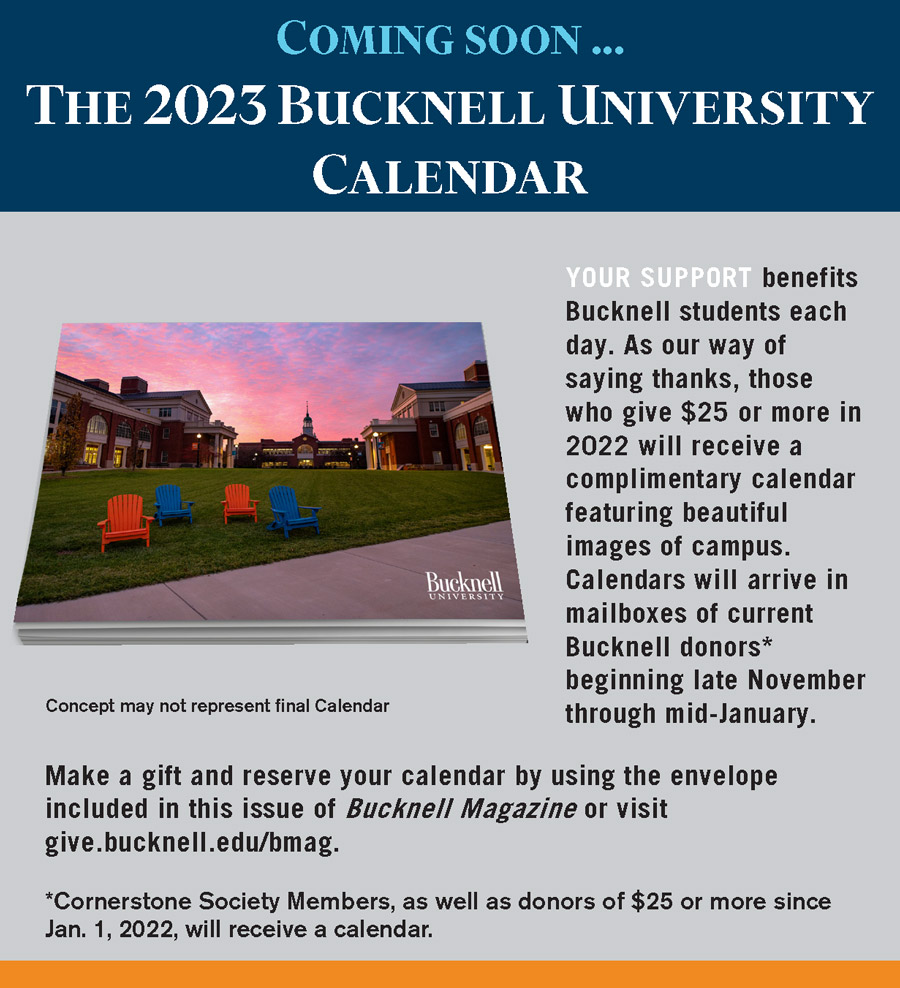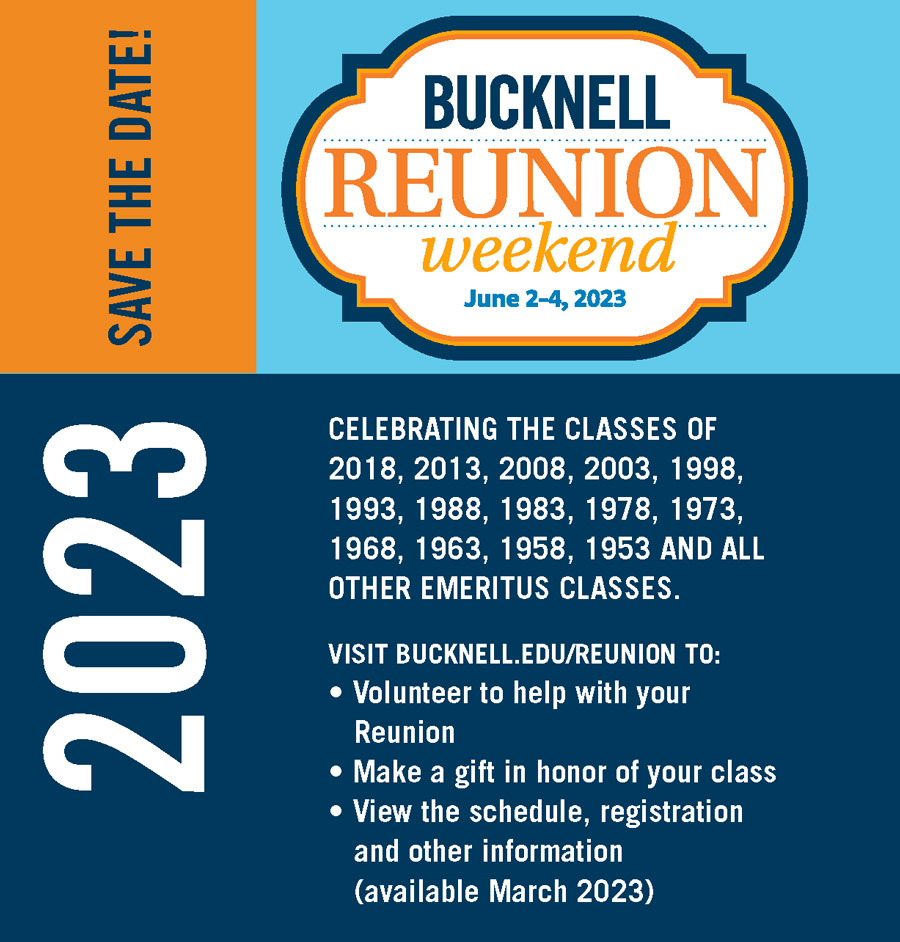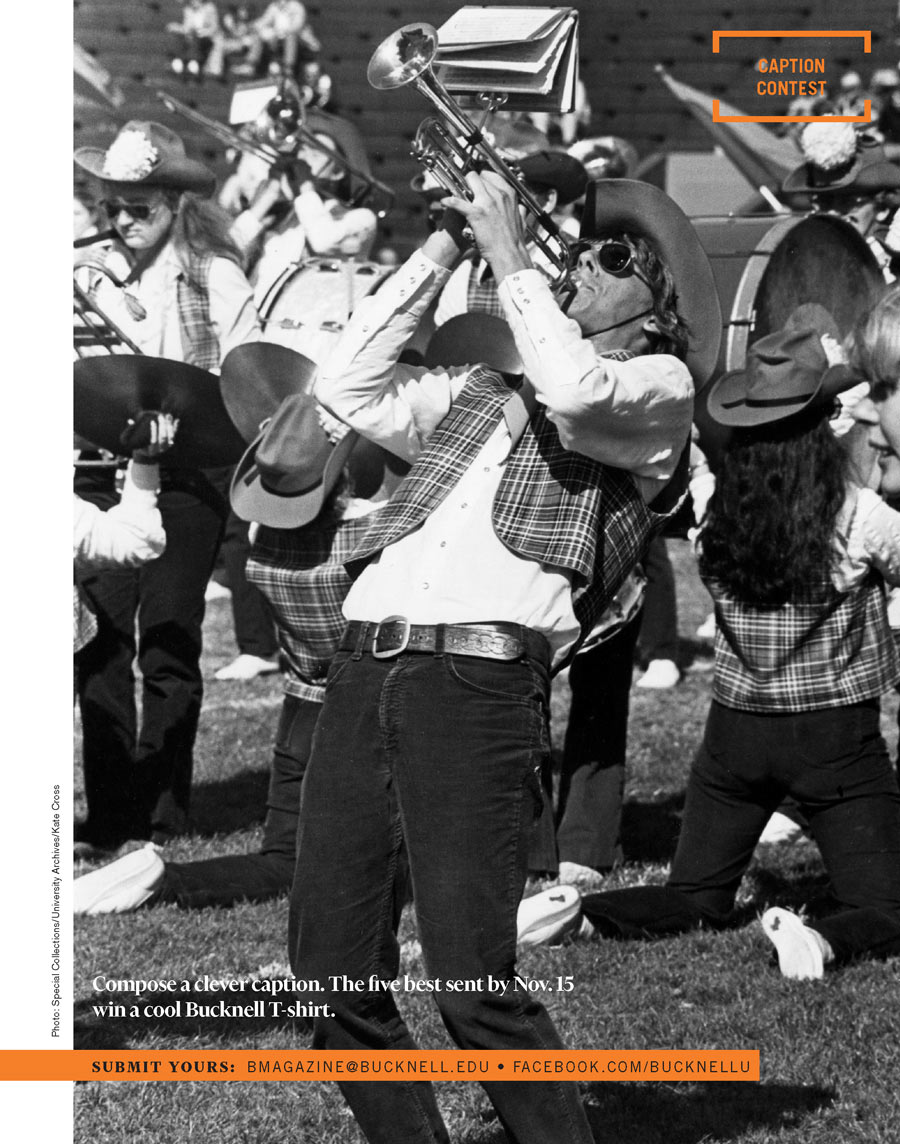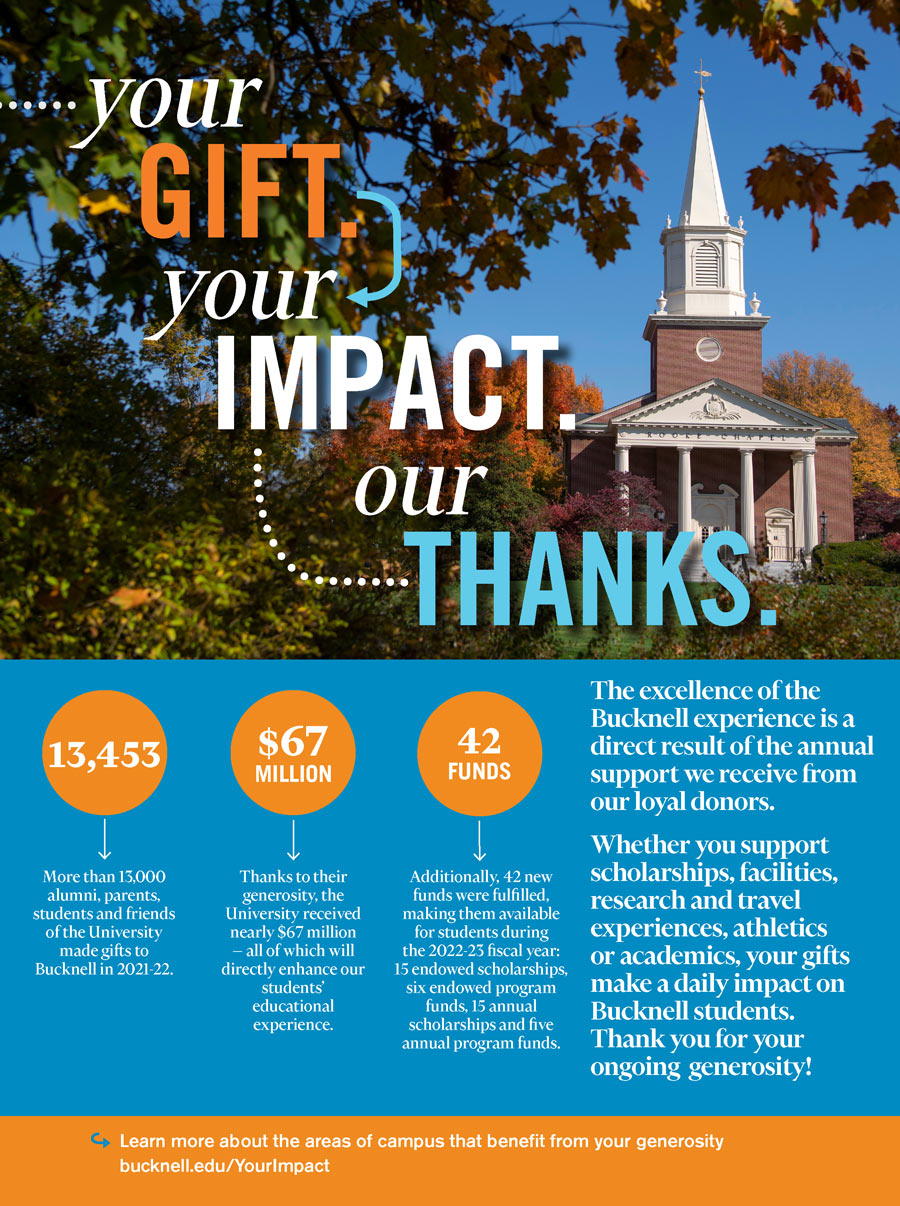Bucknell Magazine Fall 2022


BY WAY OF BUCKNELL
“THE ORANGE AND THE BLUE”
Orange-tinted trees on a bluebird fall day give us all a reason to ’ray.
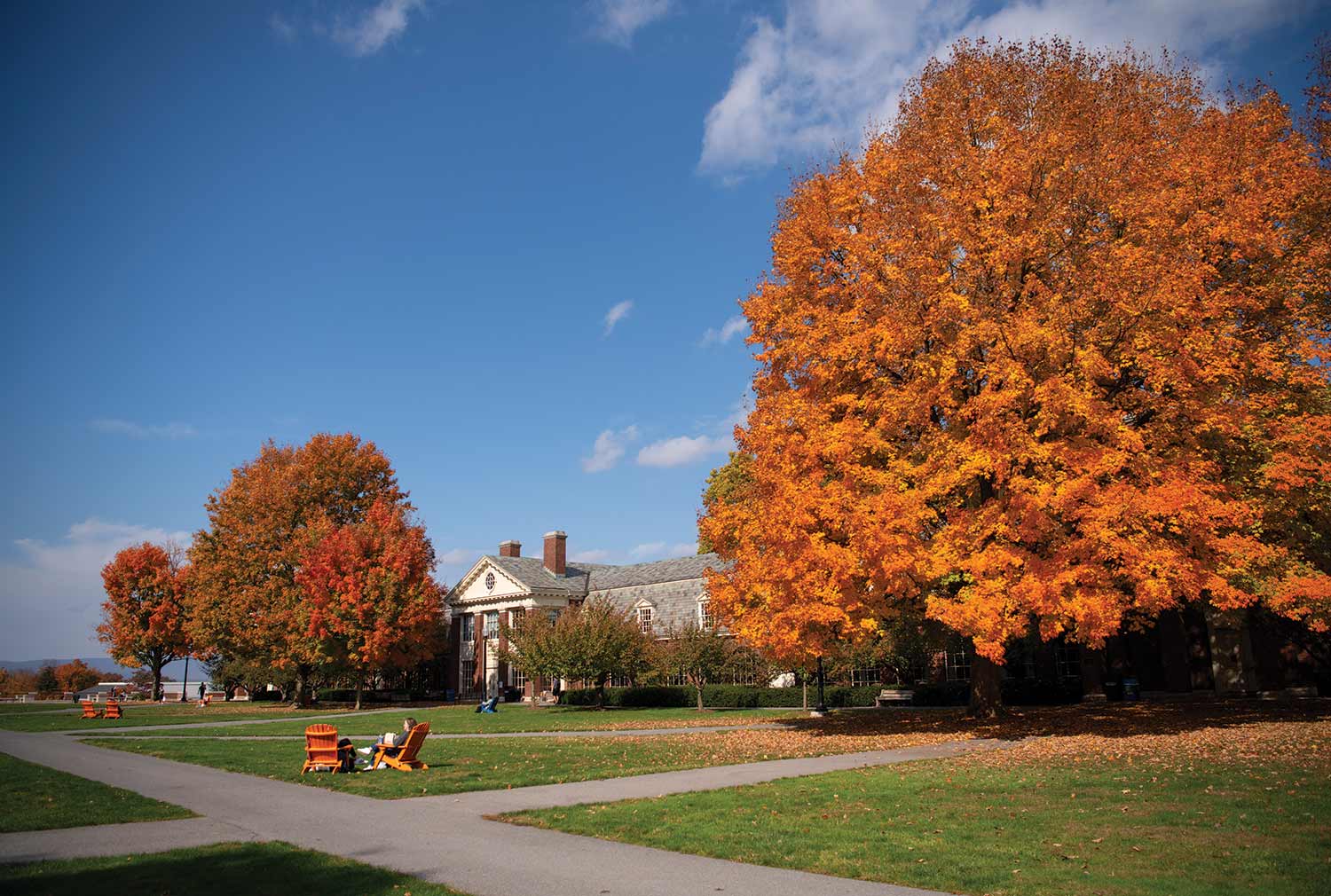
BY WAY OF BUCKNELL
Orange-tinted trees on a bluebird fall day give us all a reason to ’ray.
If you would like a reprint of this photo, please fill out the form at bucknell.edu/bmag/PhotoOffer. We will send you a complimentary 8 x 10 print.
Pathways
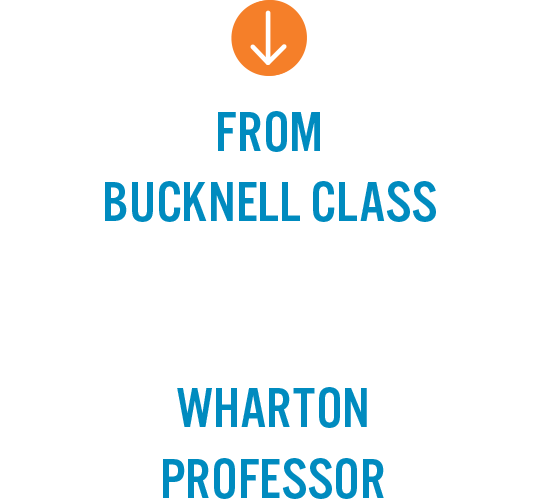
by Katie Williard
Donald Keim ’75 teaches complex concepts of finance and economics as the John Neff Professor of Finance (now emeritus) at the Wharton School of the University of Pennsylvania.
His 40-year career was sparked by a pivotal class at Bucknell — Cost Accounting with Professor Scott Cowen, management. “He opened up my eyes to how economics can be used in different ways,” Keim says.
Cowen (who went on to become president of Tulane University) also introduced Keim to the idea of pursuing higher degrees, which led Keim to earn his Ph.D. in finance and economics from the University of Chicago. There, he conducted research and studied with Nobel laureates Merton Miller; Myron Scholes, his mentor; and Eugene Fama, his dissertation adviser.
Pathways
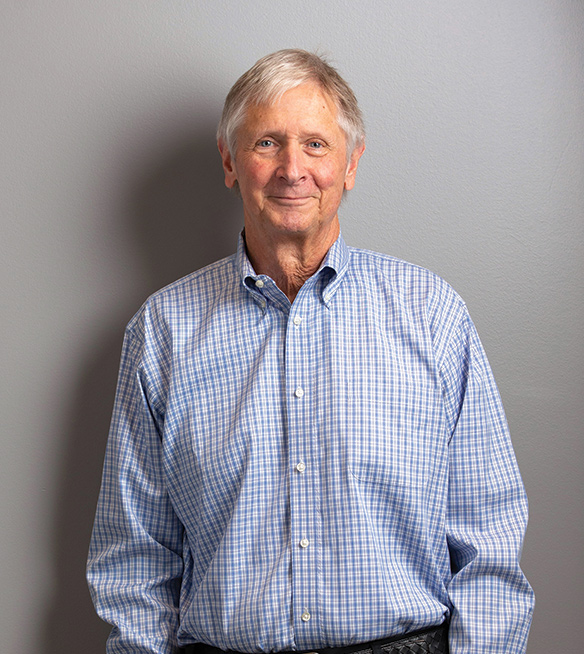

by Katie Williard
His 40-year career was sparked by a pivotal class at Bucknell — Cost Accounting with Professor Scott Cowen, management. “He opened up my eyes to how economics can be used in different ways,” Keim says.
Cowen (who went on to become president of Tulane University) also introduced Keim to the idea of pursuing higher degrees, which led Keim to earn his Ph.D. in finance and economics from the University of Chicago. There, he conducted research and studied with Nobel laureates Merton Miller; Myron Scholes, his mentor; and Eugene Fama, his dissertation adviser.
Pathways
by BROOKE THAMES
Natalia Mancero ’24 has a crystal-clear vision of what she’ll do with her Bucknell education: become a certified public accountant (CPA) at one of the “Big Four” firms.
“What’s exciting about the Freeman College of Management is how well it prepares you for the Uniform CPA Examination,” says Mancero, an accounting major from Upper Saddle River, N.J.
But earning a top score is only the first step. To land a job at one of the largest accounting firms in the United States, Mancero will need real-world experience. So in her sophomore year at Bucknell, she went hunting for just that.
With help from Bucknell’s Center for Career Advancement, Mancero began “applying for every internship I could find at New York City firms,” she says.
Pathways
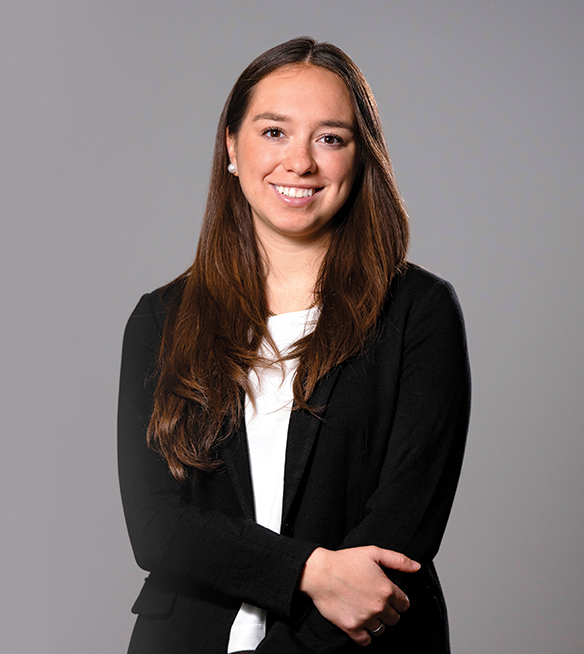

Natalia Mancero ’24 has a crystal-clear vision of what she’ll do with her Bucknell education: become a certified public accountant (CPA) at one of the “Big Four” firms.
“What’s exciting about the Freeman College of Management is how well it prepares you for the Uniform CPA Examination,” says Mancero, an accounting major from Upper Saddle River, N.J.
But earning a top score is only the first step. To land a job at one of the largest accounting firms in the United States, Mancero will need real-world experience. So in her sophomore year at Bucknell, she went hunting for just that.
With help from Bucknell’s Center for Career Advancement, Mancero began “applying for every internship I could find at New York City firms,” she says.
Gateway
A Storm-soaked ‘Odyssey’
MY HUSBAND of 53 years, Clifford James Nuttall III, ’70, M’74, and I are “Agnes survivors,” as well as survivors of Hurricane Charley in 2004 and Irma in 2017 in Florida, where we’ve resided since 2001.
In 1972, we rented a mobile home in the Bucknell View trailer park across the Susquehanna River from Lewisburg. We asked our insurance agent if we needed flood insurance, but he said floods usually occur only once every 100 years, so we didn’t need it.
Unfortunately, soon after, Hurricane Agnes dumped almost 20 inches of rain in a week. One night, we heard the siren blow as a warning for people to evacuate the flood zone. We loaded our two small cars with the cat and important papers, leaving behind wedding pictures and my wedding dress and veil hanging from a ceiling light, our stereo, TV, books and a glass-topped wooden table. Driving across the bridge, we arrived at the home of Mary and John Dohmann M’50, good friends who lived on South 16th Street in Linntown, where we had been urgently invited. The Butch Fisher family, owners of a butcher shop, came, too. We stayed there for six weeks, eating wonderful steaks and drinking high-end adult beverages, celebrating our third wedding anniversary in style. Occasionally, during the next week, we drove up the hill by the Bucknell infirmary to look over the cliff at the flooded river and our upside-down trailer. Others were in similar disarray. Later, former students told me that they knew which was our trailer because, as members of the National Guard patrolling in boats, they found copies of the Odyssey test floating on the water, exams on a book I taught at Lewisburg Area High School. Later, we received our tetanus shots and were allowed to forage in the mud-filled, sharp metal-fragmented trailer; we found someone had stolen the TV, the stereo and the glass tabletop. Our good china was still unbroken in the high cabinets in the kitchen, cushioned by mud between each dish. We found a mud-covered $5 bill and our browned clothes. We ended up throwing away most of the clothes, too spoiled to save.
The federal government granted us a Small Business Administration (SBA) loan of $5,000 to replace what we had lost and a furnished Housing and Urban Development (HUD) trailer placed on the exact site where we had lost the rented one. Every time it rained, I walked from our trailer to check the river, even though we owned next to nothing. With the SBA funds, as long as we replaced what we had lost, we did not have to repay the loan. Six months later, with the money we had saved from our teaching jobs over the course of three years, we put down a down payment on a lot high on a hill in Turbot Hills, Milton, and built a new bilevel home.
Naples, Fla.
BACK FROM BAGHDAD
I’M SO EXCITED to see the article about Matthew Bogdanos ’80 [Summer 2022]! He visited my city of Ocala, Fla., several years ago to talk about the looting of the Baghdad Museum at our own Appleton Museum of Art. I got to meet him and exchange memories of our alma mater 20 years apart. Thank you for the excellent update on his marvelous and important career!
‘ray Bucknell!
Ocala, Fla.
A Nifty Idea
I JUST FINISHED READING the Summer ’22 issue. As always, it was interesting, uplifting and informative. Great work!
The profile of student Jack Casturo ’24 mentions a personal project of his: the “flashing LED ‘Thank You’ display for a car’s rearview mirror.” I’ve always wanted something like this: a sign on the back window of my car to thank courteous drivers. I’d love to be a beta tester for Jack’s design! He’s welcome to email me anytime.
Baltimore
BACK FROM BAGHDAD
I’M SO EXCITED to see the article about Matthew Bogdanos ’80 [Summer 2022]! He visited my city of Ocala, Fla., several years ago to talk about the looting of the Baghdad Museum at our own Appleton Museum of Art. I got to meet him and exchange memories of our alma mater 20 years apart. Thank you for the excellent update on his marvelous and important career!
‘ray Bucknell!
Ocala, Fla.
A Nifty Idea
I JUST FINISHED READING the Summer ’22 issue. As always, it was interesting, uplifting and informative. Great work!
The profile of student Jack Casturo ’24 mentions a personal project of his: the “flashing LED ‘Thank You’ display for a car’s rearview mirror.” I’ve always wanted something like this: a sign on the back window of my car to thank courteous drivers. I’d love to be a beta tester for Jack’s design! He’s welcome to email me anytime.
Baltimore

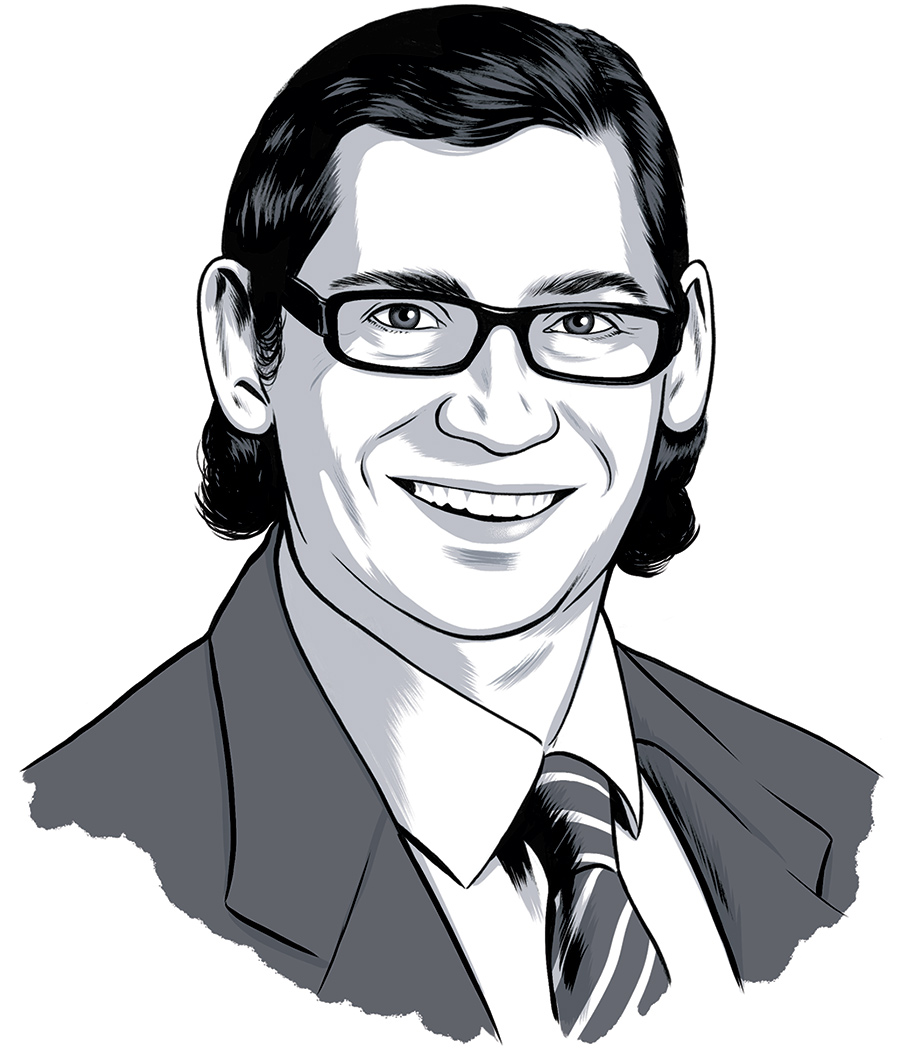
Bringing You the Best
AT BUCKNELL, we expect the best. When I temporarily took the helm of this magazine six months ago, with that expectation in mind, I set two goals.
The first was to try my utmost to live up to the high standard established by the most recent editors, Sherri Kimmel and Gigi Marino, as well as the corresponding high expectations of our readers, who share an abiding passion for this University. The second was to find a new editor who not only had the technical prowess, writing verve and eye for design needed to carry a magazine as good as this one from preliminary planning to your mailbox and inbox, but who would also pour as much love and care into that process as I have.
Frankly, anxieties might be a better word than goals; they definitely kept me up at night. The affinity so many of you feel for this place is one I share, and when I care about something as much as I care about Bucknell, I don’t do anything halfway. Everyone whose name is listed on the masthead to the right of this column shares that commitment, working very hard to capture just a fraction of the dynamic and diverse spirit of this special place.
I’m pleased to tell you today that I’m sleeping much easier. Beginning with the Winter 2023 issue, this magazine will be helmed by Katrin “Katie” Neitz, our new editor and associate director of editorial strategy.
Katie brings to Bucknell Magazine more than 20 years experience working on both mass market and college magazines. For 17 of those years she worked for publisher Rodale, where she was an editor for Men’s Health, Women’s Health and Runner’s World. Most recently, she served as editor-in-chief of the Lafayette College alumni magazine, and contributed to their quarterly admissions magazine.
Katie was the unanimous choice in a field that included editors currently working for some of the top colleges and universities in the world, in addition to applicants with similarly strong private-sector experience. I have no doubt that we found the best.
It has been one of the highlights of my career to give my best to this publication. But I am even more excited to see where Katie will take it next. I’ll be reading along with you.
Agnes Recalled
THE ARTICLE AND PICTURES about Tropical Storm Agnes in the Spring 2022 issue were grim reminders of my having witnessed the flooding firsthand. [Professor] Bill Cooper, the economics department chair, had given me a summer job funded by a National Science Foundation grant. My off-campus apartment was on St. Anthony Street, very near the Susquehanna River. As Agnes roared into Lewisburg in the overnight hours, I realized this was not just any storm — the buckets of rain seemed endless. So much so, I was awake most of the night cautiously monitoring the deluge. The open area behind my apartment was filling up extremely fast, and by morning it was clear that immediate evacuation was in order. Market Street was under 10 feet of water, and the only way out to higher ground on the Bucknell hill was via someone’s improvised boat taxi with an outboard motor. Imagine floating the length of Market Street and seeing the tops of parked cars totally submerged by flood water!
My then girlfriend, Sheri Cappell Morant ’73, was also in Lewisburg that summer doing research for [Professor] Alan Leshner in the psych department. Sheri and I sought refuge at the mostly empty Sigma Chi house for several days until the flooding subsided. Food and drink was a bit catch-as-catch-can during that time, but I do recall finding coffee in the house kitchen. And who do I remember helping me search for that first morning cup of Joe? None other than University President Charlie Watts, who was out and about the campus conducting a personal assessment of Agnes’ wrath. The next time I was that close to President Watts was a year later when he shook my hand and gave me my diploma at graduation.
Thom Miller ’73
Ladera Ranch, Calif.
Table of Contents

Volume 15, Issue 4
Vice President For Communications
Heather Johns
INTERIM EDITOR
Matt Hughes
CREATIVE DIRECTOR
Barbara Wise
DESIGN
Amy Wells
Barbara Wise
PHOTOGRAPHY EDITOR
Emily Paine
DIGITAL EDITOR
Brooke Thames
ASSISTANT EDITOR
Katie Williard
CLASS NOTES EDITOR
Heidi Hormel
EDITORIAL ASSISTANT
Kim Faulk
Contributors
Brad Tufts
Mike Ferlazzo
Christina Masciere Wallace P’22
Shana Ebright
Website
bucknell.edu/bmagazine
Contact
Email: bmagazine@bucknell.edu
Class Notes:
classnotes@bucknell.edu
Telephone: 570-577-3611
Bucknell Magazine
(ISSN 1044-7563), of which this is volume 15, number 4, is published in winter, spring, summer and fall by Bucknell University, One Dent Drive, Lewisburg, PA 17837. Periodicals Postage paid at Lewisburg, PA and additional mailing offices.
Permit No. 068-880.
Circulation
49,000
Postmaster
Send all address changes to:
Office of Records,
301 Market St., Suite 2
Bucknell University, Lewisburg, PA 17837
© 2022 Bucknell University
Please recycle after use.
speaker series
Condoleezza Rice Addresses ‘The State of American Democracy’
JUST TWO DAYS after the 21st anniversary of 9/11, Condoleezza Rice — the national security advisor to President George W. Bush when the terrorist attacks of Sept. 11, 2001, took place — appeared via Zoom in a Weis Center for the Performing Arts discussion with her friend and former Stanford University colleague, President John Bravman, to kick off the return of the Bucknell Forum speaker series.
Rice, now the Tad and Dianne Taube Director of the Hoover Institution, the Denning Professor in Global Business and the Economy at the Stanford Graduate School of Business, and a professor of political science at Stanford University, told a captivated audience how those attacks changed American national security for good. The hourlong discussion also touched on her time in office, the nation’s political polarization, Russia’s threat to the U.S. and education reform.
The first female African American secretary of state and first woman to serve as national security advisor, Rice opened the program saying “the state of American democracy is not as we would like it to be.” She then cited three elements that cause her concern.
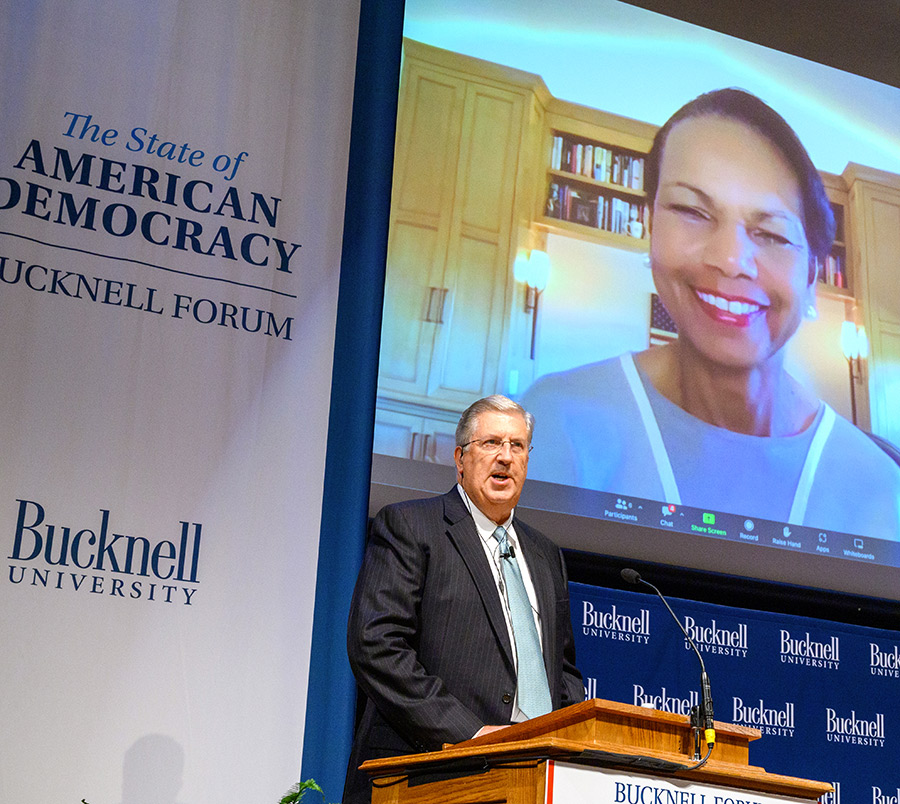

News Ticker
LEADING TALENT
STAGING ACTIVISM
SERVING THE WORLD
AROUND TOWN AND AROUND THE GLOBE
’burg and Beyond
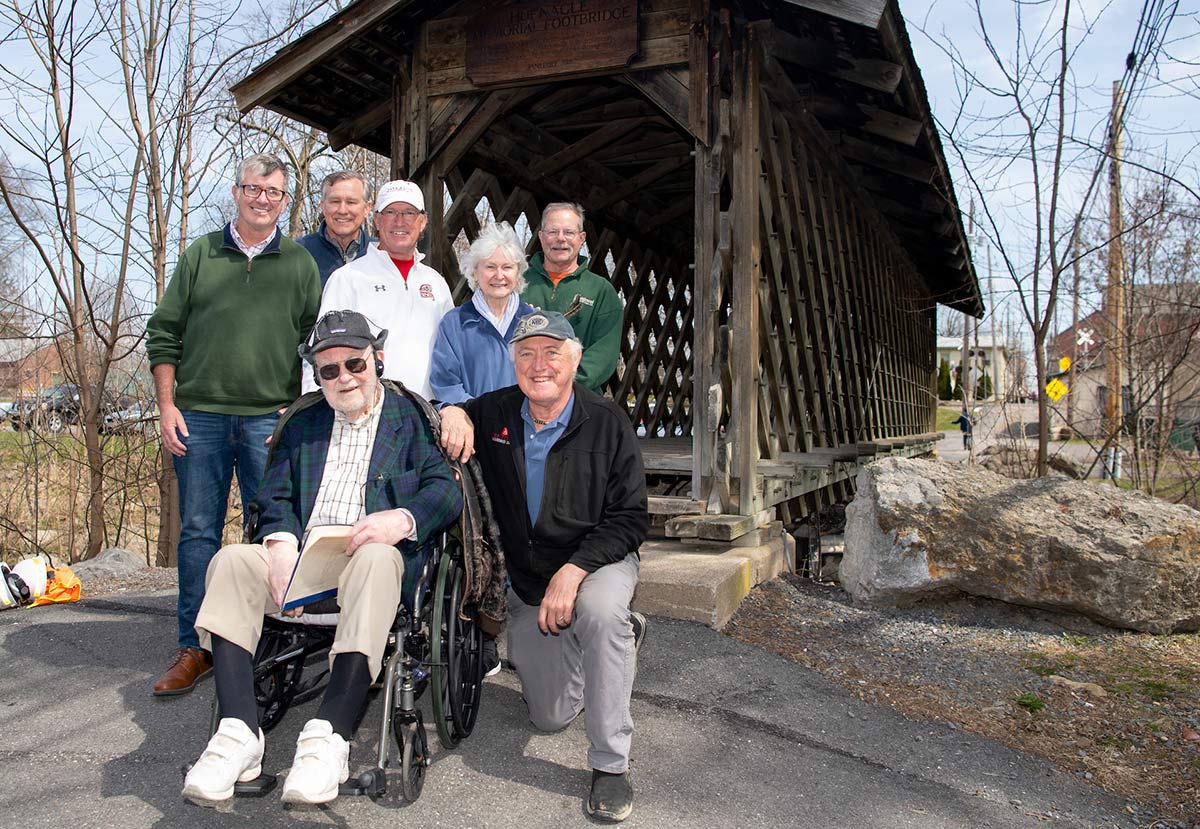

Rear: Patrick McNierney ’83, Brian Hassinger ’82, Randy Cassidy ’82, Miranda McGinnis, Jim Muffly ’82
 Lewisburg, Pa.
Lewisburg, Pa.
In fall 1980, Lewisburg Mayor Lewis Hendricks visited Professor Dick McGinnis’ civil engineering class. The borough was looking to revitalize the area around Limestone Run, better known downtown as Bull Run, and Hendricks asked students for help.
Randy Cassidy ’82 proposed an idea: a pedestrian footbridge crossing the creek at Cherry Alley that could withstand the force of future floods.
“I thought we would build a model, put some strain gauges on it, write a report and move on with life,” Cassidy says. His senior design professor, Robert J. Brungraber G’05, had other plans. “The heck with that,” he told him. “We’re gonna build it.”
AROUND TOWN AND AROUND THE GLOBE
’burg and Beyond
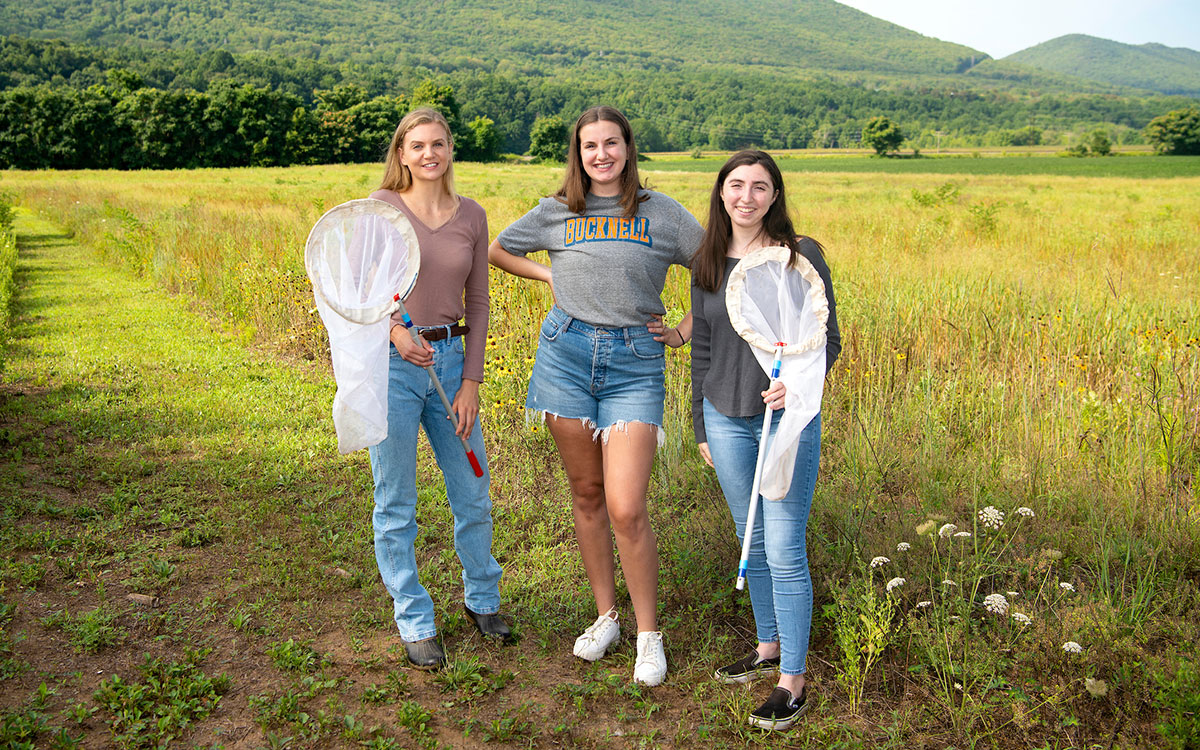

 South Williamsport, Pa.
South Williamsport, Pa.
On the bank of the Susquehanna River in South Williamsport, Pa., lies a nearly 230-acre plot with a history tracing back centuries — from the Indigenous people who first settled the land to the birding expeditions of environmentalist Robert Porter Allen, who rescued entire species from extinction in the 1940s. Today, Sylvan Dell is Bucknell’s newest site for student exploration and discovery, thanks to a collaboration between local partners and the Bucknell Center for Sustainability & the Environment (BCSE).
What They Do
Since spring 2021, students have pursued historical, environmental and civil-interest projects on Sylvan Dell’s wetlands and former farmstead. They’ve charted the site’s environmental features, crafted proposals for a regenerative agricultural farm and hosted a public “bio blitz” to identify local animal species.
This past summer, Eleanor Geno ’23 began investigating the history of an Indigenous village that may have once existed where a nearby oil terminal now sits.
Perhaps no one knows this better than Bucknellians, which is why the University has introduced a new way for students to chart their four years of knowledge, exploration and growth. Launched last academic year, the Pathways program encourages students to thoughtfully integrate their curricular and co-curricular experiences through the creation of a digital portfolio.
Equipped with a range of tools for writing, displaying photos, embedding documents and more, this highly customizable personal site allows for vivid mapping of the college journey — from Orientation to graduation. But the Pathways portfolio is more than an amalgamation of a student’s accomplishments in the classroom — it’s an exercise in self-discovery.
“We often say that we want students to meditate on their Bucknell experience, but then we find ourselves asking, ‘Well, where do they do that?’ ” says Joseph Tranquillo, associate provost for transformative teaching & learning. “This initiative aims to provide a place where students can do that in a meaningful way.”
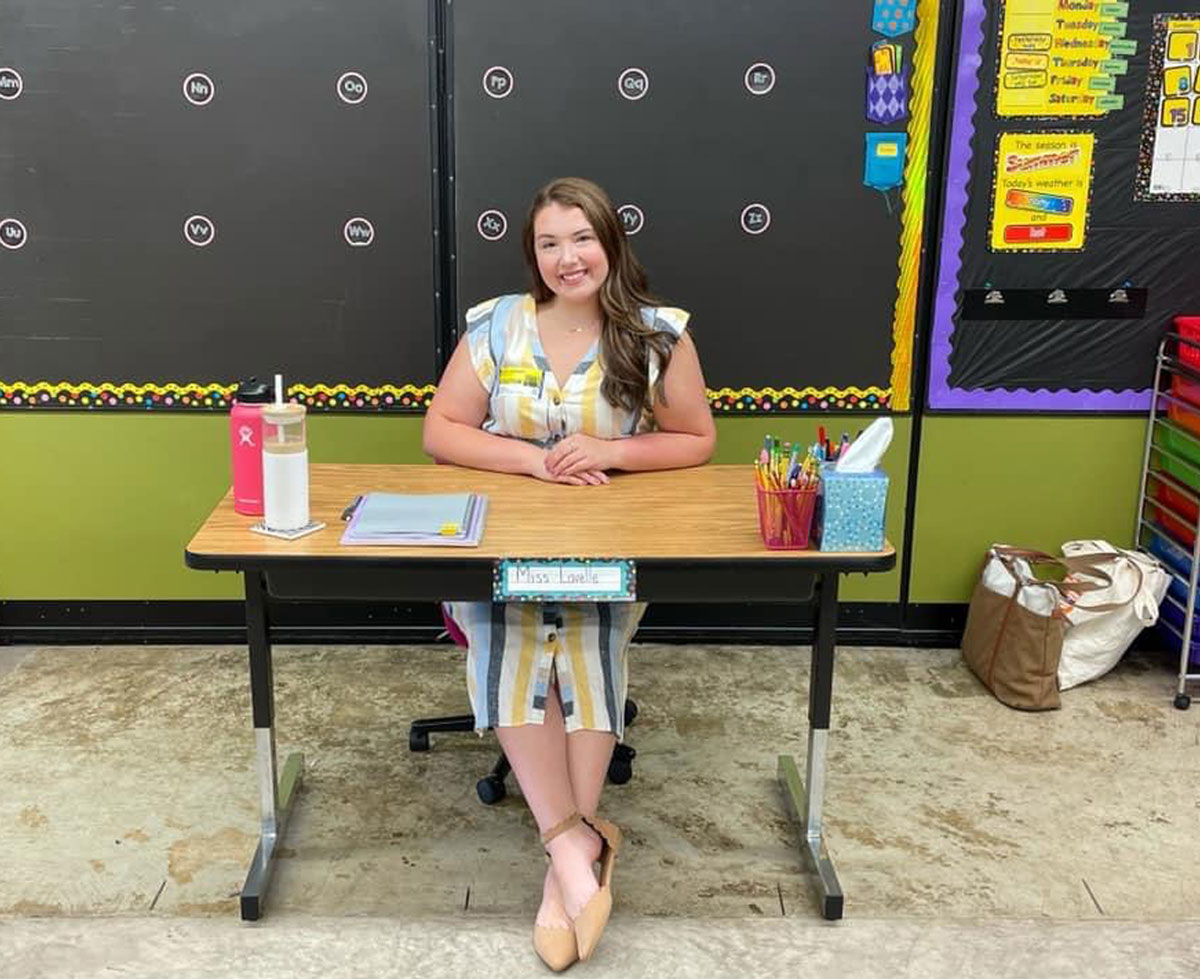
Photos: Courtesy of Lainey Lavelle ’22


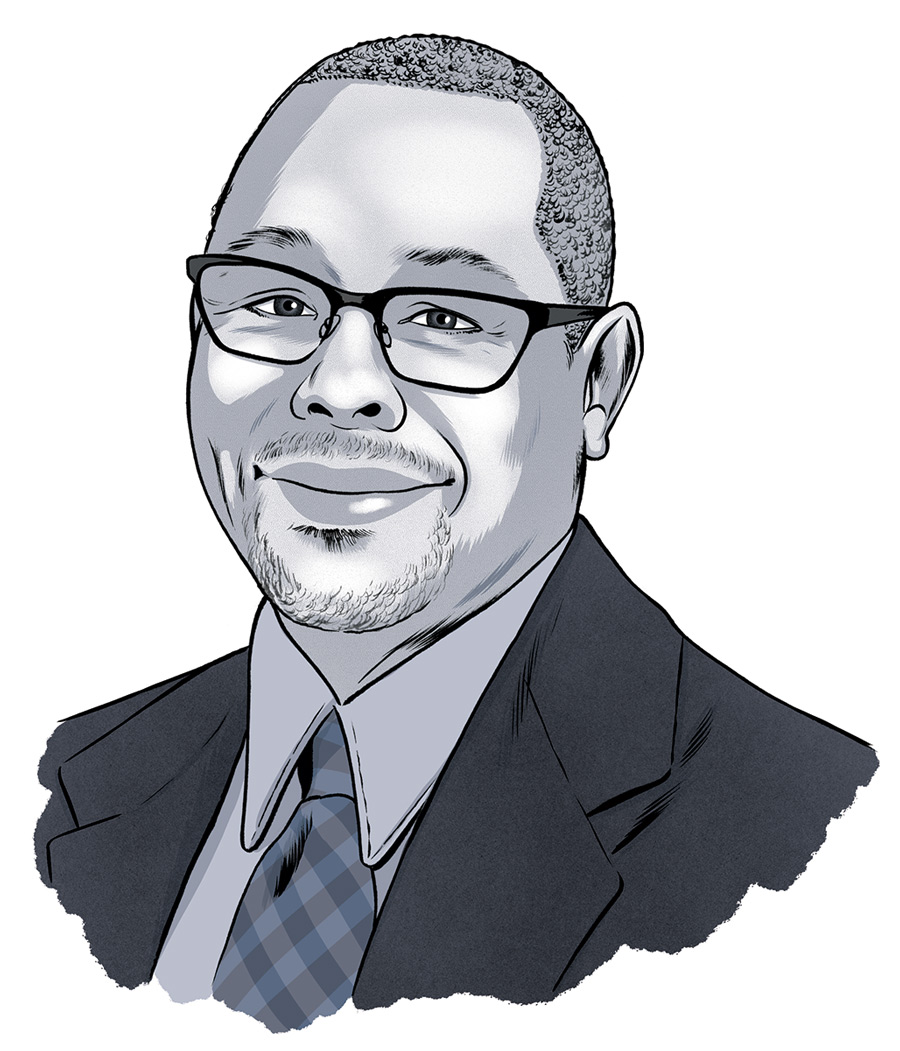
Bringing the World to Bucknell
As director of Bucknell’s Office of Global & Off-campus Education, Stephen Appiah-Padi understands the importance of mapping a travel plan, because “if you don’t know where you’re going, you’ll never get there.” That’s the idea behind Bucknell’s new Internationalization Lab, a committee of faculty and staff working to chart a coordinated, futuristic path toward achieving Bucknell’s vision of becoming a more global institution. Appiah-Padi is one of the passionate committee members leading the charge.
How do you define global education and why is it important that Bucknell students be ready to live and work as “global citizens”?
Global education is teaching and learning that focuses on the complex interrelationships between various people, traditions, cultures, civilizations and religions — as well as geographic entities that have informed and continue to inform our understanding of the world we live in.
Globalization as an economic phenomenon has played a large part in breaking down past barriers between nations. The world is becoming more connected every day; yet with the destruction of old barriers, new ones arise — mainly because of inequities in the system of globalization. It would be a great disservice to not focus on teaching students about the complexities of modern-day intranational and international relations or to not equip them with the skills to function within those dynamics.
There’s no better way to do this than by working with our own diverse student, faculty and staff populations on campus, and tailoring our academic and administrative practices to reflect the kind of knowledge, skills and perspectives that will serve our students as they enter the world post-Bucknell. Global education is now an educational imperative, not a choice.
How to Excel
t was mid-July when Morgan Powell ’26 first made the robot’s finger move. On the table in front of her, a 3D- printed piece attached to an actuator — a flexible mechanical device that can be inflated to change the shape of something — bent like a finger. “It functions through air sent from a pump, which is manipulated using an Arduino,” Powell says, using the brand name for a small, single-board microcontroller. “Compared to some of the other models that have been designed, this one is a bit thicker and doesn’t curve as much. We’re going to make it thinner and add more chambers to increase the curvature and improve its strength.”
Within just weeks, Powell and three of her peers would accomplish their goal of creating a handlike soft robotic device that could lift a weighted cup — research aimed at improving the lives of those who rely on prosthetic limbs.
Watching Powell explain her team’s design and effortlessly manipulate the digital model she built using Fusion 360 software, one could easily mistake her for a rising junior or senior doing summer research. But the Weyers Cave, Va., native and 17 other first-year students from across the country had never studied in a college lab before. Instead, they were jumping headfirst into life as Bucknell engineers through the Engineering EXCELerator program.

— Brooke Thames
Blown Away
Under the guidance of mechanical engineering professors Nate Siegel and Craig Beal, four Bucknell engineers devised methods to test an innovative wind turbine designed by a Pennsylvania- based energy company. Unlike traditional pinwheel-shaped turbines, this novel tower-like generator rotates on a vertical axis, allowing it to respond to wind from any direction and withstand higher wind speeds. The project continues this fall with efficiency-measuring experiments using turbine models and data-collection devices built by student researchers.
The Makings of a Movement
Intrigued by the intersection of personal beliefs and politics, religious studies and political science double-major Paris Gallagher ’23 dove into studying how the ideas of fringe communities can shape the mainstream political landscape. Her research — overseen by Professor John Penniman, religious studies — focused on the QAnon phenomenon, specifically the group’s presence on social media and reputation within religious denominations in the United States.
chasing the Salesman
Computer science majors teamed up with Professor Samuel Gutekunst, computer science and mathematics, to take on one of the most famous algorithmic puzzles in history: the Circulant Traveling Salesman Problem. Given a list of cities and the distances between them, what is the shortest possible route that visits each city exactly once and returns to the starting point? It’s one of the most intensively studied problems in computational optimization and, with funding from a National Science Foundation Grant, students made promising breakthroughs in their quest for an answer.
Creative Collaboration
Each week, 10 student interns at the Bucknell Small Business Development Center worked with corporate partners to craft creative solutions for commercial challenges. These Bucknellian consultants helped develop a data-tracking system for an exercise aid, construct a device for testing fabric elasticity and advise a fast-casual food chain on a new approach to marketing — touting its clean and convenient bathrooms.
Bucknell Welcomes Two ’99 Alumni to Board of Trustees
Two graduates who crossed the Commencement stage in 1999 have returned to Bucknell as members of the Board of Trustees. Made up of alumni, parents and friends of the University, the board guides the strategic direction of Bucknell through shared leadership expertise.
The new appointees, Martin Gilliard ’99 and Laurie Schmidt ’99, began five-year terms in July. Each brings significant leadership experiences to the role, where they will work to align the University’s key initiatives with its strategic goals.
At Bucknell, Gilliard double-majored in business management and studio art and was on the men’s basketball team. He went on to receive executive education at Northwestern University’s Kellogg School of Management and serves as the senior director and head of Meta Store — Reality Labs for tech giant Meta, formerly known as Facebook.
Schmidt joins the board with nearly 20 years of experience with Goldman Sachs Asset Management, where she is a partner. She received a bachelor’s of science in business administration with a focus on accounting and began her career at PricewaterhouseCoopers. Schmidt also serves on the board for the Cornelia Connelly Center, a New York City nonprofit supporting under-resourced girls from middle school through college and beyond.
At the spring Board of Trustees meeting, President John Bravman also thanked three outgoing board members, Michael Flowers ’76, Steve Holmes ’79, P’06, P’08 and David Maurrasse. “Their significant contributions to the board and generosity to this University will be felt by generations to come,” Bravman said.

It’s all about the ability for plants to read and respond to their environment. As the days get shorter and temperatures get cooler, deciduous trees (the ones that drop their leaves) respond by slowly shutting things down for the winter. One key step is “retiring” their leaves for the year and reclaiming whatever resources are in them. As those elements are recovered, the green pigment plants use to absorb light for photosynthesis (chlorophyll) is drained from the leaves.
When all of that green disappears, yellow and orange pigments that were largely hidden by the chlorophyll are revealed. Red and purple pigments also accumulate, especially when autumn days are bright and cool. The result is a beautiful, multi-colored show before the leaves fall to the ground.
Of course, not every woody plant goes through this process. Many trees and shrubs are evergreen and don’t shut down their leaves in the fall. This can be a risky habit because leaves require water to sustain them, and when water is frozen during winter, it is not available for uptake. Evergreen leaves — like the leaves of rhododendrons or the needles of conifers — tend to be resistant to drying out, employing thick “skins” and waxy coverings to protect whatever water they can acquire during the colder months.
Our curious questions about nature, history, human behavior and more are the essence of Bucknellians’ everyday work. Why do leaves change color in the fall? Professor Chris Martine, biology, has the answer.

Photo: Emily Paine
Professor Chris Martine
David Burpee Chair in Plant Genetics & Research,
Director of the Manning Herbarium
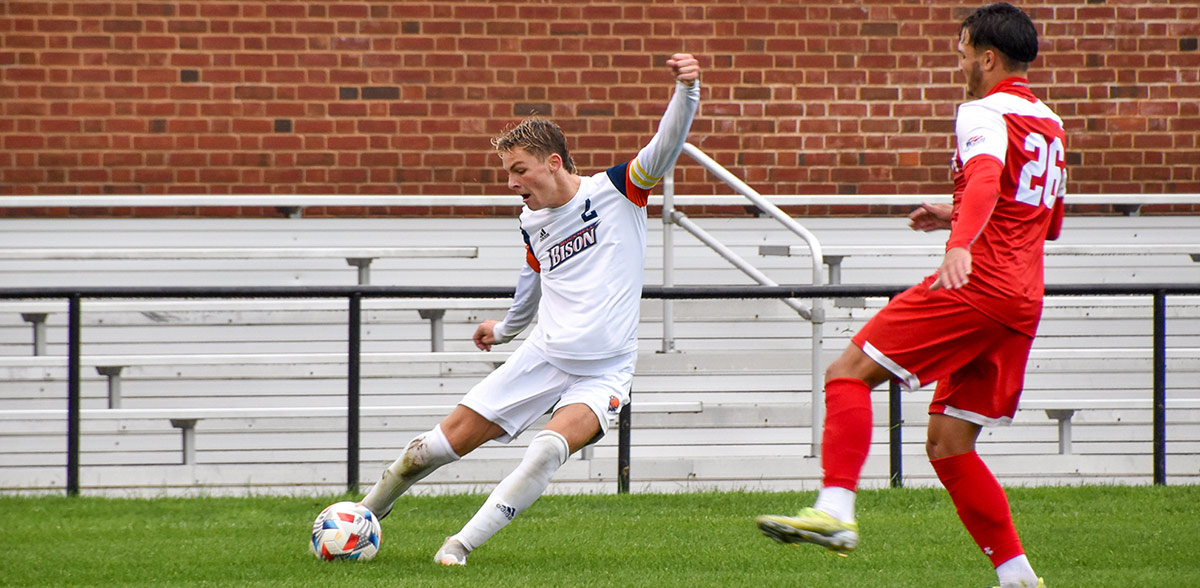

Looking Upfield
But Kuczura found something meaningful in the sport: joy.
“When you’re on the field, you don’t have to worry about anything except what’s going on in front of you,” says the economics major, whose mother played competitively at Temple University. “You get out there, clear your mind and have some fun with your buddies.”
It’s an attitude that contributed to Kuczura’s selection as captain of the Bison men’s team his sophomore year — making him the youngest player to serve in the role. While the 2021 team endured hardships — the squad experienced coaching turnover and the arrival of a dozen new players, en route to a withering 4-10-3 final record — Kuczura remained fixated on the big picture.
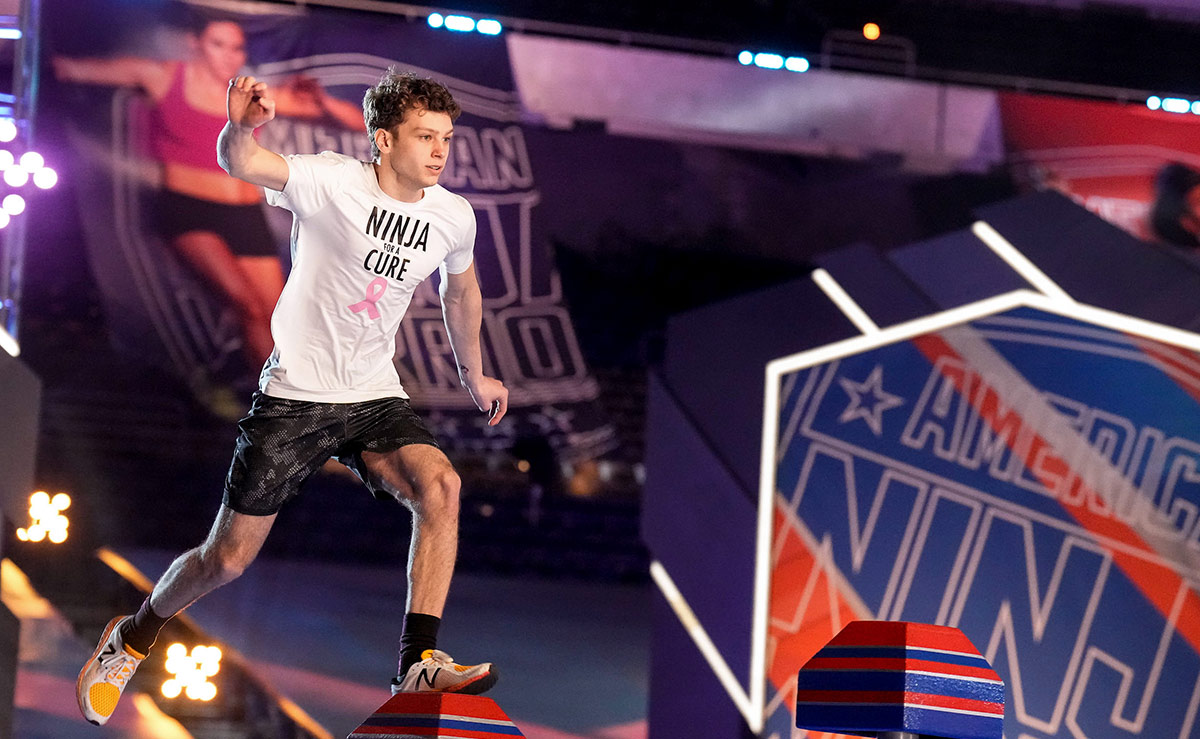

New Jersey Ninja
This spring, he got his shot.
On June 13, Behrle made his debut on American Ninja Warrior, the reality competition show in which contestants try to conquer a punishing obstacle course that tests strength and balance in equal measure. The episode, filmed in March in San Antonio, Texas, showed him completing the first four obstacles of the program’s larger-than-life course before falling on the Piston Plunge — a performance good enough to earn him a return in the Los Angeles semifinal.
Bucknellian Brickmasters
hen Abby Strayer ’22 looks back on her college graduation, she’ll have more than cards once stuffed with cash, the memory of a fancy dinner or a souvenir from a celebratory summer trip to spark fond memories of that special day. Thanks to her imaginative parents, she’ll own a handcrafted tribute to her college years — a model of Bucknell’s Rooke Chapel, constructed entirely of LEGO bricks.
Using architectural blueprints sourced from the University, Tim Strayer P’22 designed a build-it-yourself kit of the iconic campus building. “My wife and I wanted to present a graduation gift that was both interesting and meaningful,” he says.
The couple was inspired by their family’s years-long affinity for tinkering with the construction toys. It’s a hobby that began when Tim and his wife, Carmen Pancerella P’22, coached their daughter’s middle school team through the FIRST LEGO League Challenge, in which young students build and program a LEGO robot to complete a series of tasks. From there, the Strayers endeavored to become amateur Brickmasters, transforming their basement into a LEGO lab, where they’ve assembled everything from a 900-piece retro diner to a 3,000-piece treehouse.
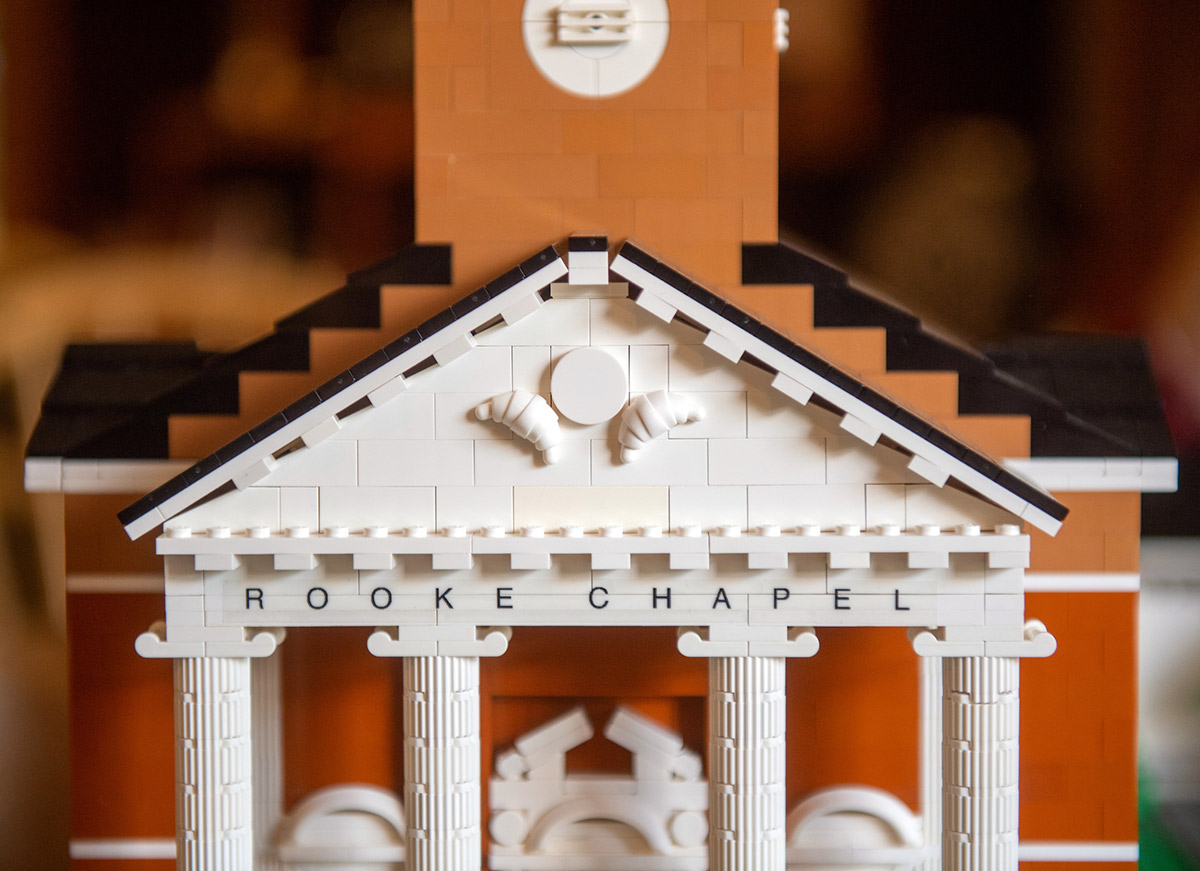
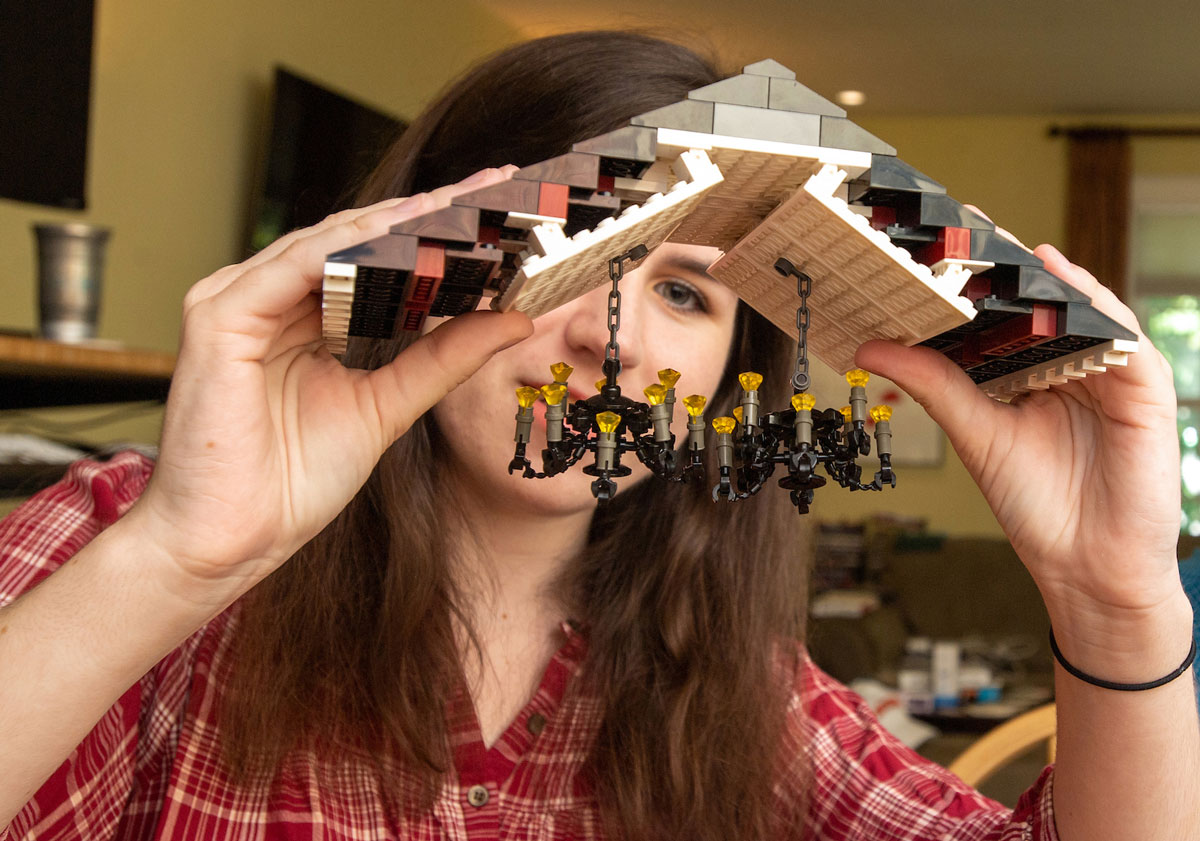


In It for the Laughs
 When Matt Nelsen ’10 started his job at a utility in San Francisco, he had no intention of pursuing his interest in comedy as anything more than a hobby. Twelve years later, the former engineer is a filmmaker, combining his analytical nature with the freedom he finds in creating smart, comedic entertainment.
When Matt Nelsen ’10 started his job at a utility in San Francisco, he had no intention of pursuing his interest in comedy as anything more than a hobby. Twelve years later, the former engineer is a filmmaker, combining his analytical nature with the freedom he finds in creating smart, comedic entertainment.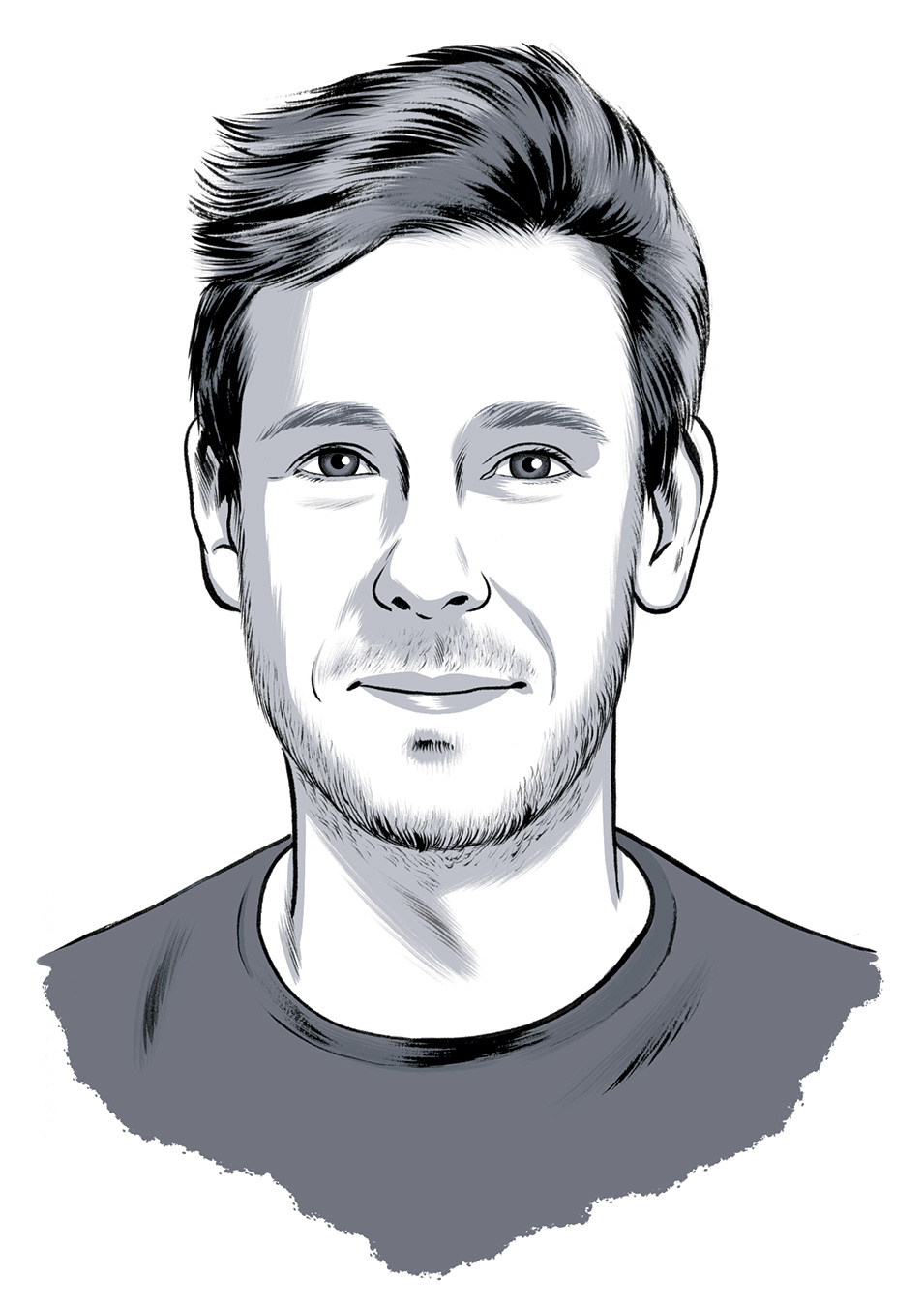
I did a little performing in high school, but auditioning for the improv group We Brake for Nobody when I got to Bucknell is what really propelled my interest.
Right out of college, I moved to San Francisco to work as an engineer. I did a few comedy shows around the city and that led me to a new improv theatre. I started doing more shows and teaching classes, and when the theatre’s founder moved to Chicago, I took it over with two other people.
Eventually it got to be too much, and there was this fork in the road where I had to choose between a very solid union engineering job — with consistent pay and pension and everything — and the comedy route, which is obviously very different.
Features
Features
Features
The Grand Art Bazaar
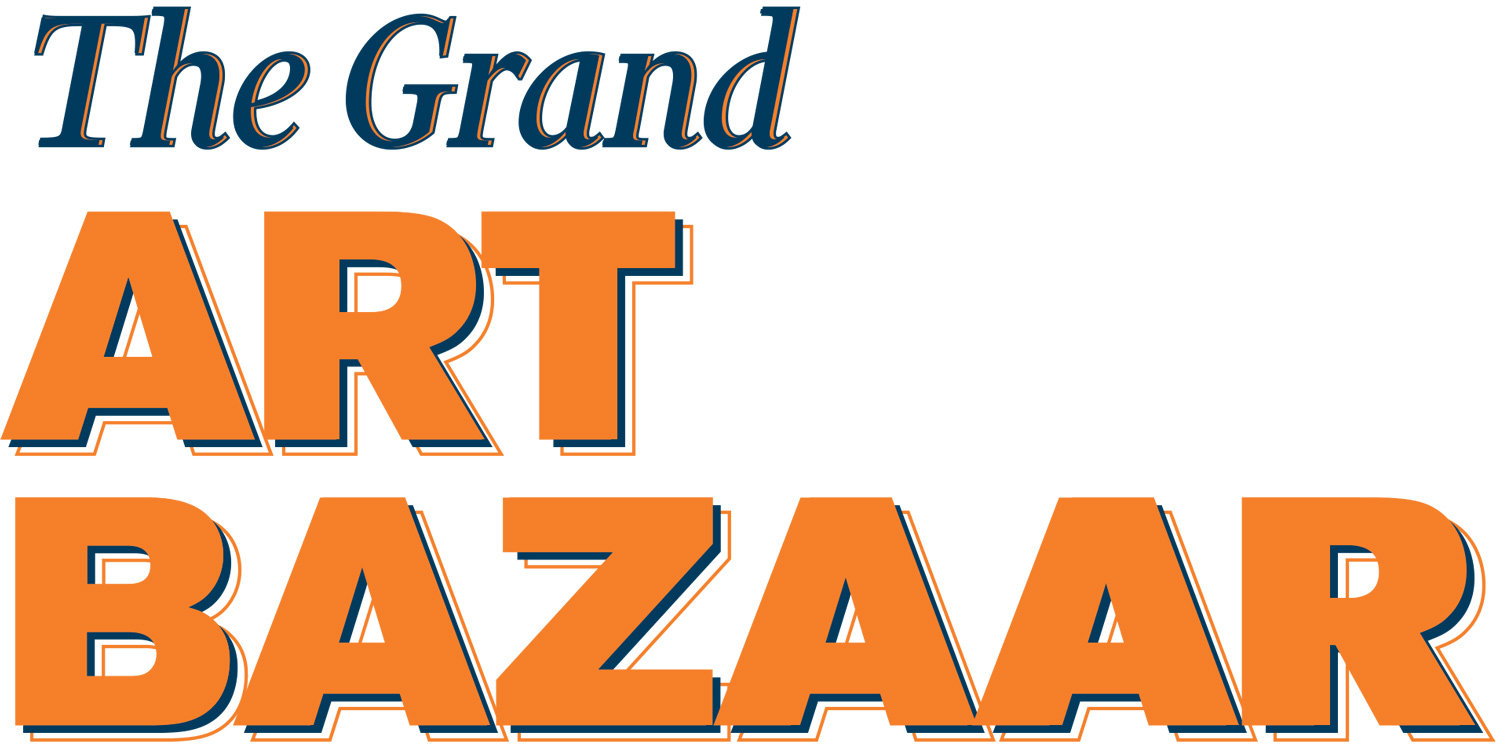
Bucknellians are shaping the debate.
illustrations by Phil Foster
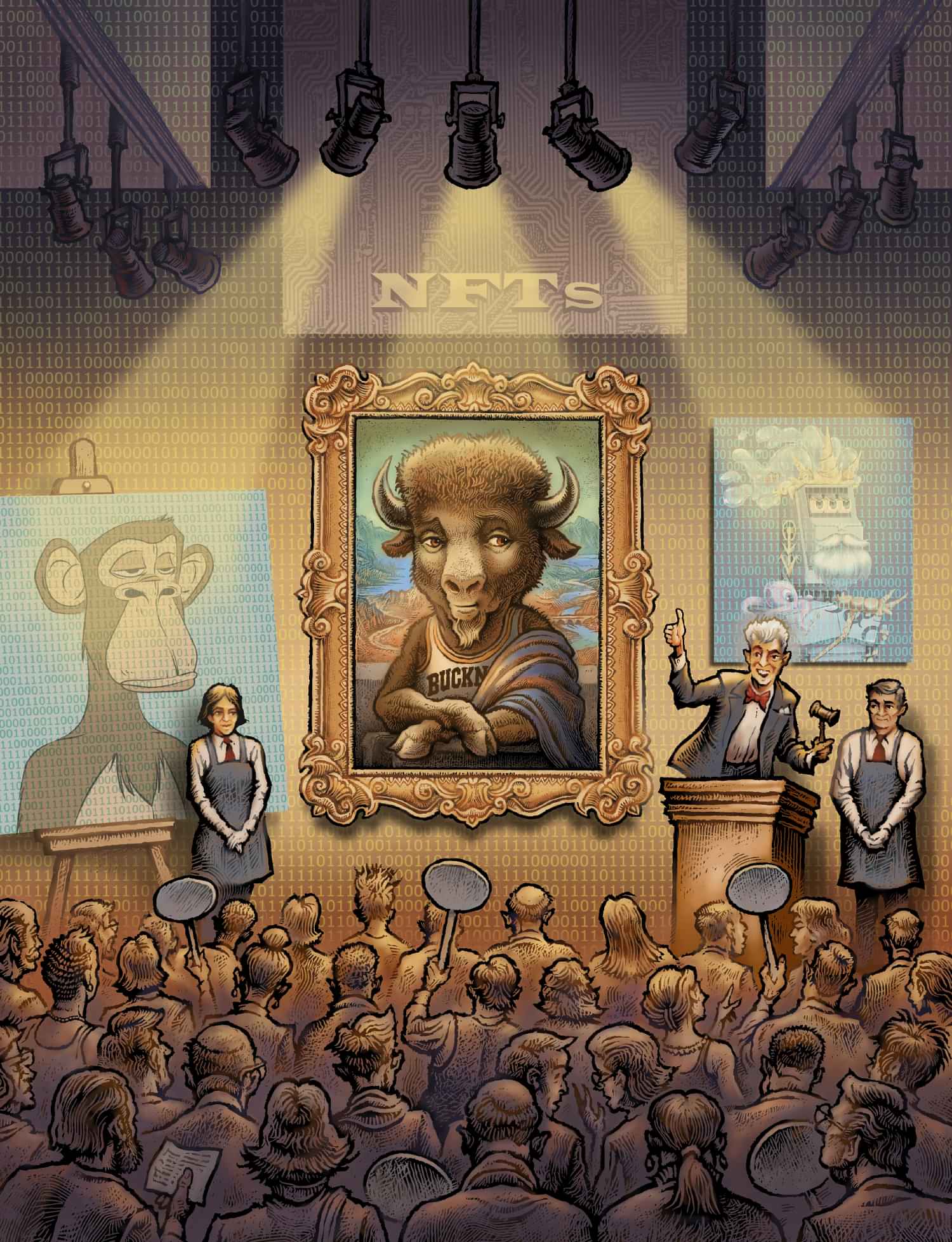
The Grand Art Bazaar

Bucknellians are shaping the debate.
illustrations by Phil Foster
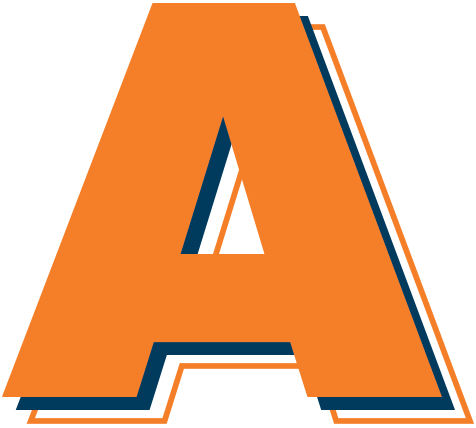
The National Basketball Association sells ones that feature highlight-reel plays. Major League Baseball sells them as a digitally enhanced version of the traditional baseball card. Musicians build fan clubs around ownership of them.
We’re talking about the economic phenomena known as non-fungible tokens, or NFTs, and they’re causing serious buzz — so much so that The Collins English Dictionary anointed “NFT” as its Word of the Year in 2021. Anything that can be created in a digital format — an image, a video, a sound clip, a 3D virtual reality session — can be made into an NFT. These unique digital collections of ones-and-zeroes use blockchain technology to store information as discrete, unalterable sets of data and stash them throughout the vast reaches of cyberspace. NFTs appear poised to revolutionize the worlds of art, music, finance and even the internet itself.
Becoming Bucknellians


photos by EMILY PAINE, DOUGLAS KILPATRICK and APRIL BARTHOLOMEW
The date is Aug. 17, and Bucknell University has just welcomed more than 1,000 first-year and transfer students to campus for a momentous beginning to their college journeys. Held across the five days leading up to the fall semester, New Student Orientation immerses incoming classes in endless opportunities to meet and bond with peers, experience the collegiate classroom and cement their place as Bucknell’s newest generation of scholars.
It’s a program that stands out from those at other institutions, not only for its impressively detailed schedule but also for its thoughtful design.
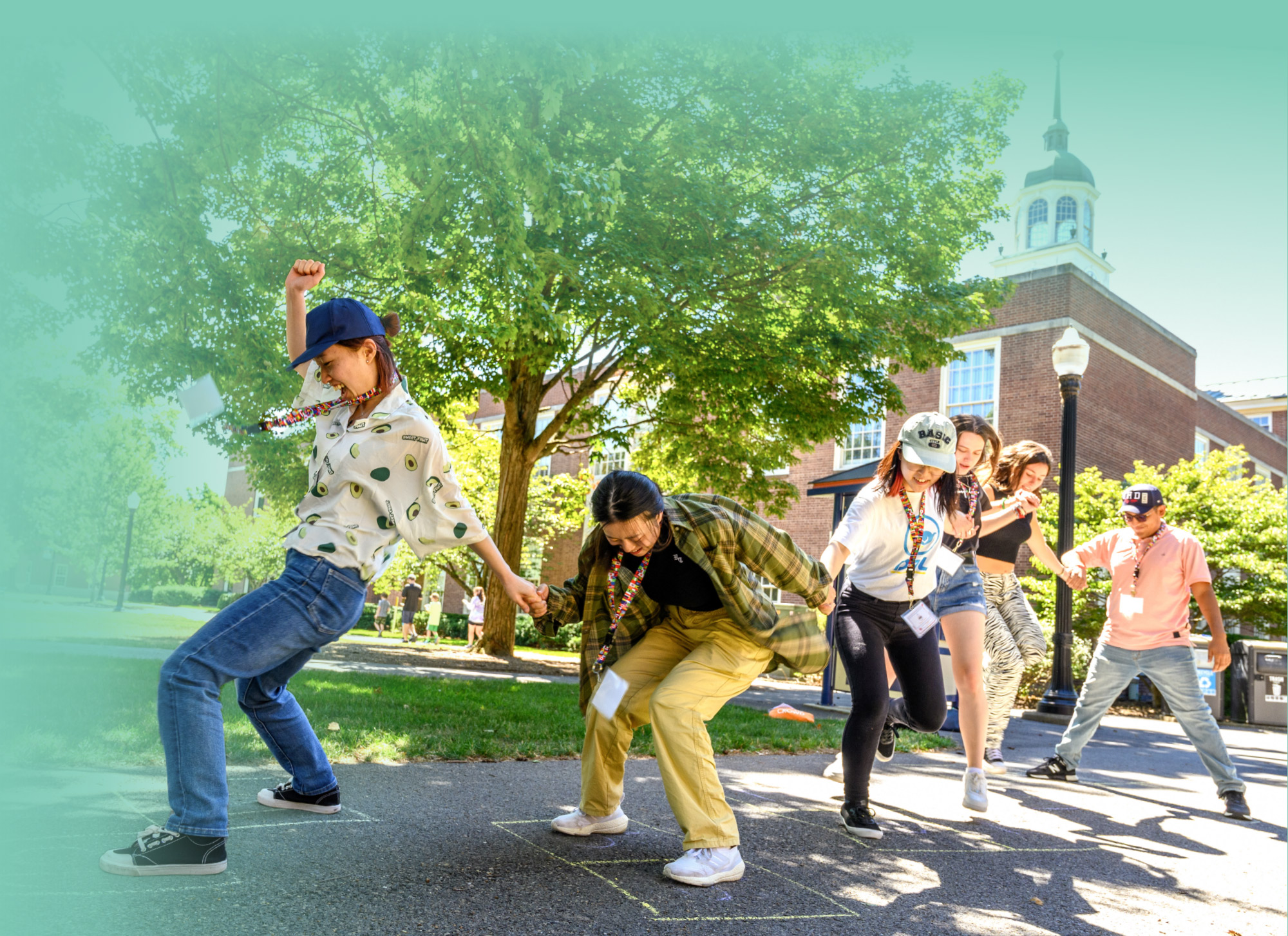
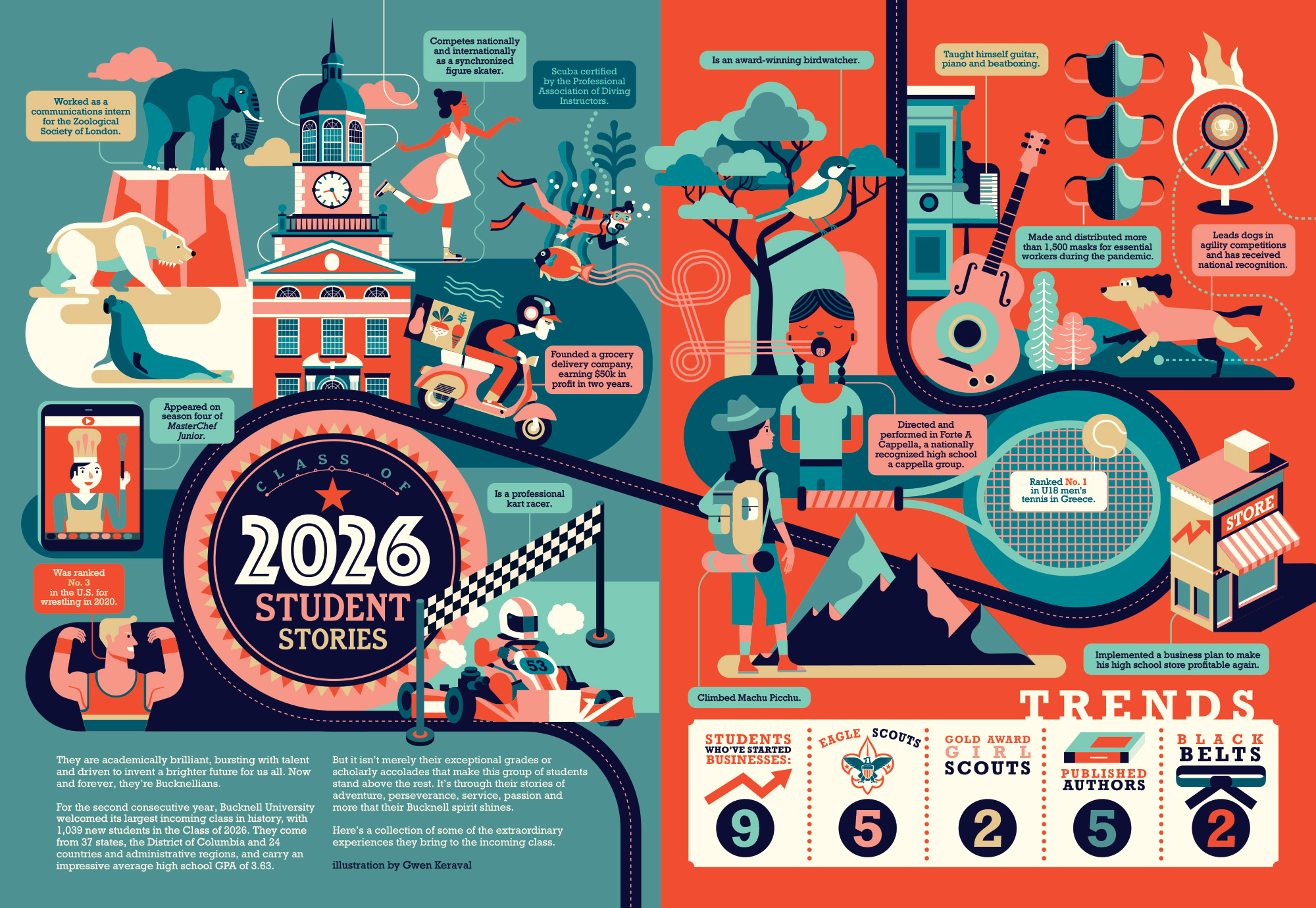
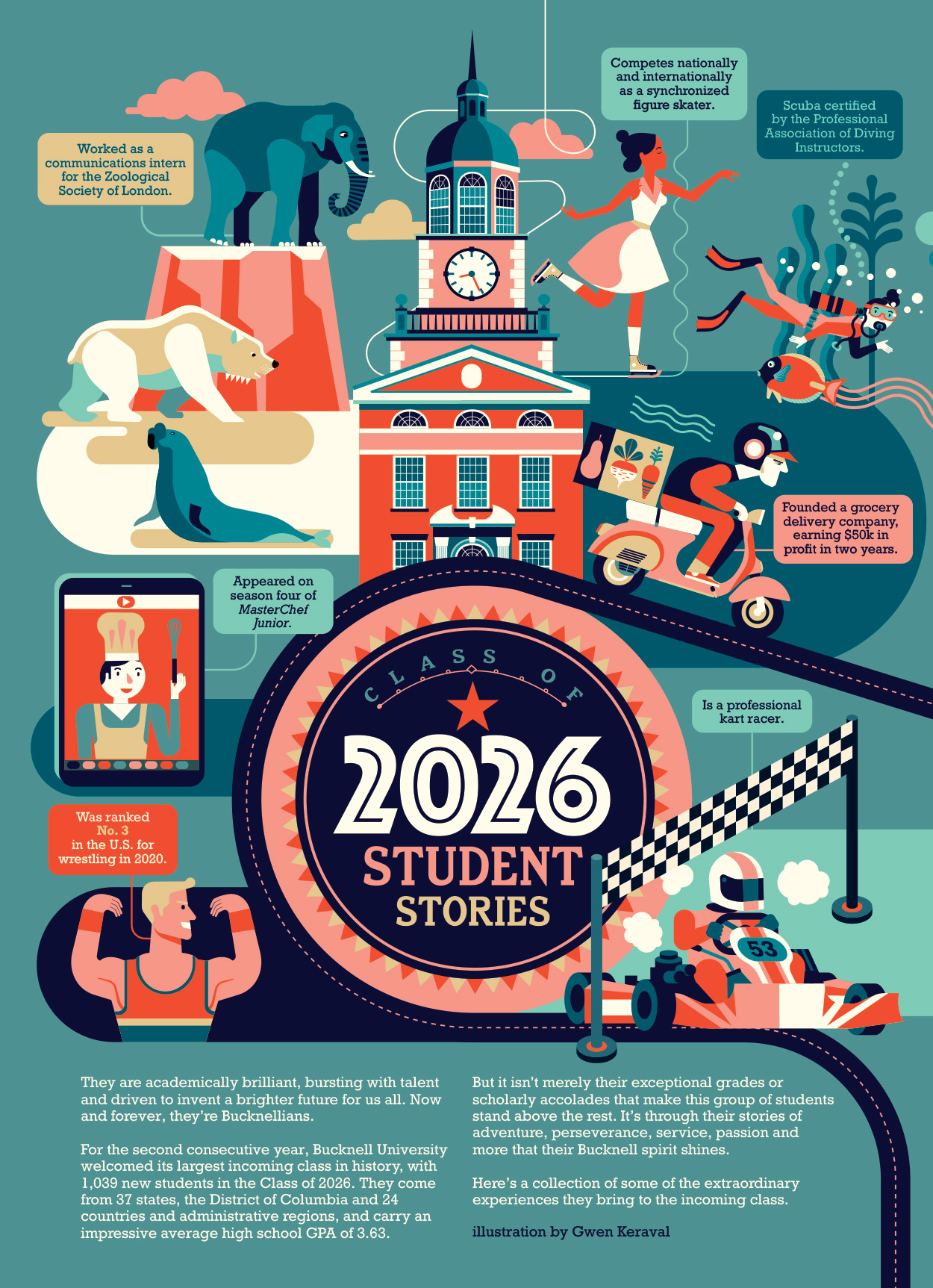
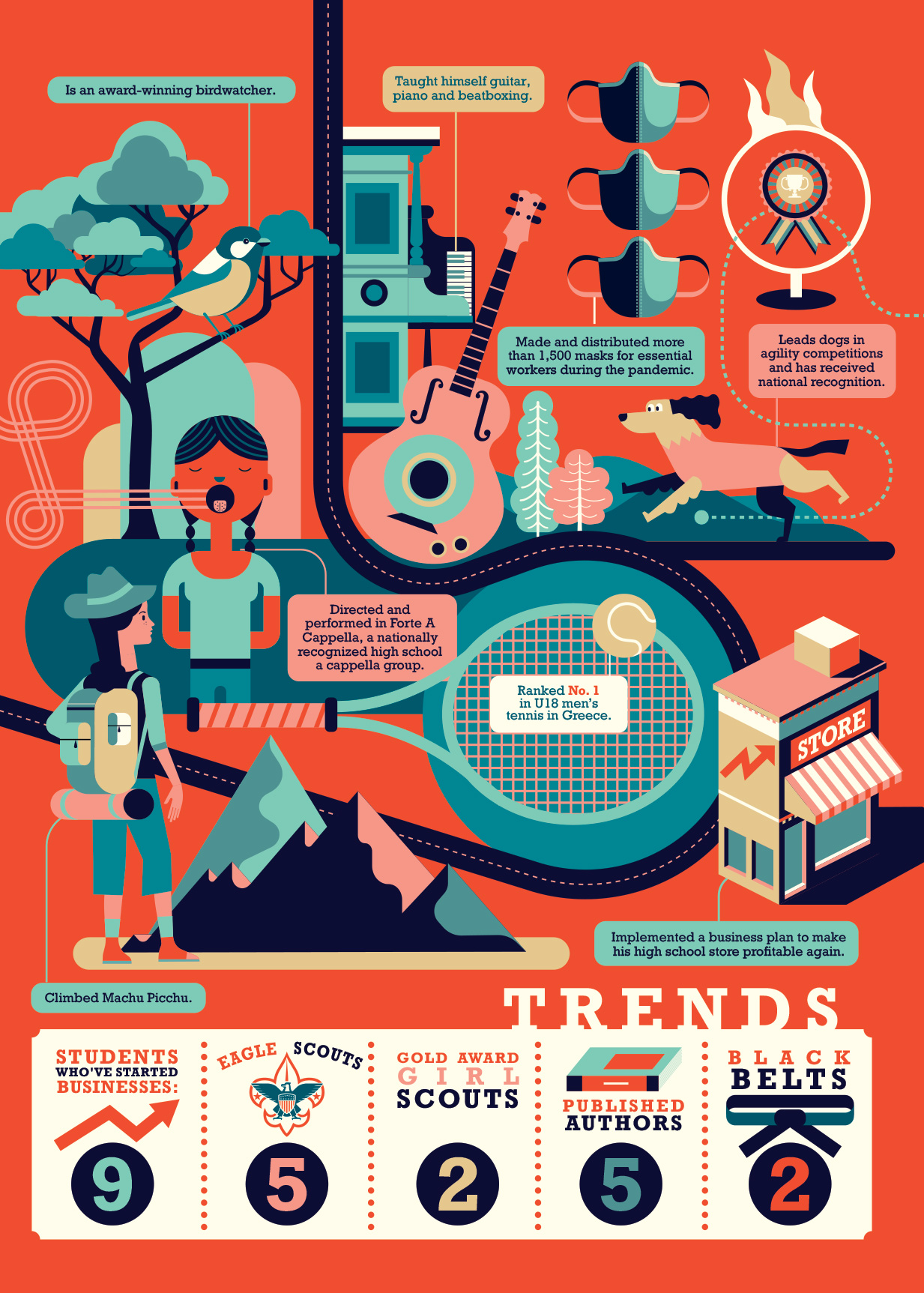
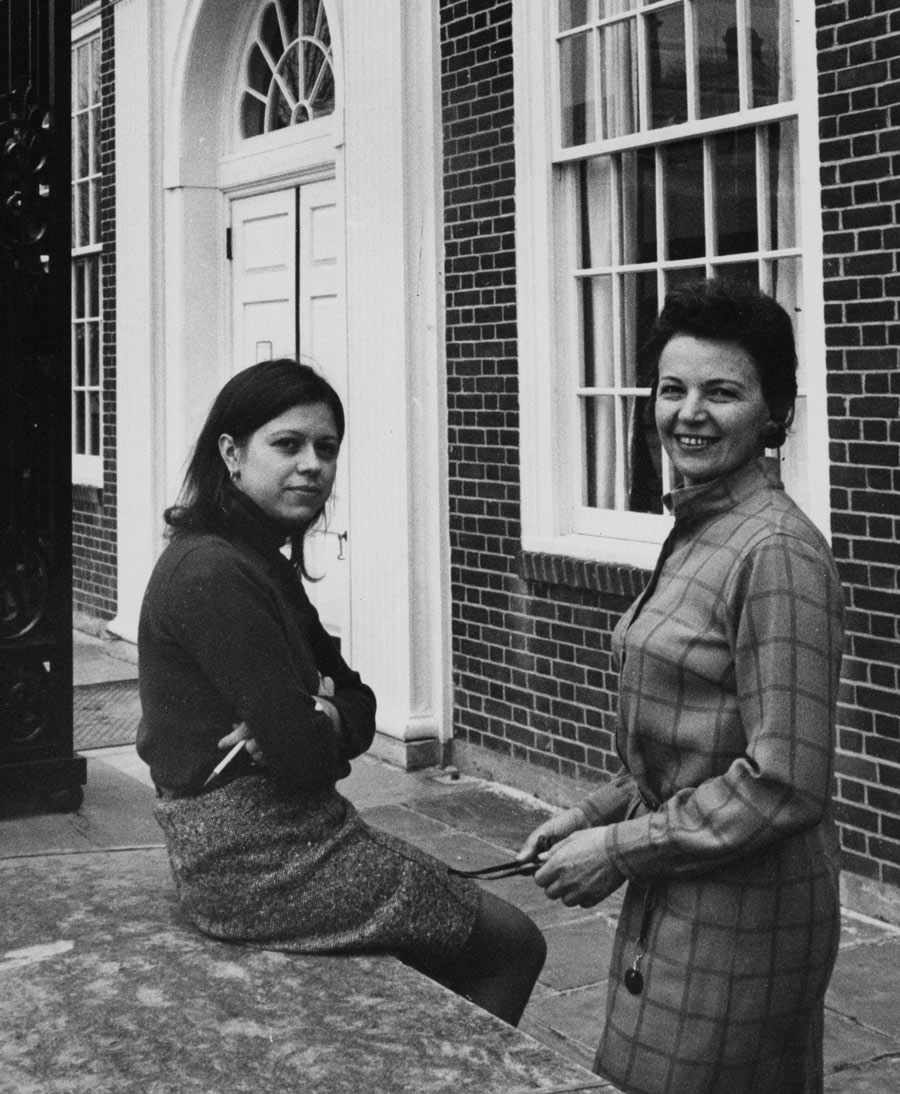
The Outlaw


She was led to the underground garage of the U.S. District Court for the Middle District of Pennsylvania in Harrisburg and placed in a car. It was 1972, and the Vietnam War raged across the Pacific. Horn had refused to testify in a nationally publicized case against seven peace activists, and now one university.
In June 1972, Tropical Storm Agnes wreaked massive destruction across central and eastern Pennsylvania, killing three people in Lewisburg and causing extensive flood damage in the borough and on the Bucknell campus. But another crisis earlier that year had already rocked Bucknell and Lewisburg. For 10 weeks from February to April 1972, six Roman Catholic peace activists and a journalist faced trial in Harrisburg for allegedly conspiring to blow up heating tunnels under Washington, D.C., and kidnap presidential adviser Henry Kissinger. The defendants became known as the Harrisburg Seven, and the prosecution’s case was based primarily on testimony from an FBI informer installed at Bucknell.


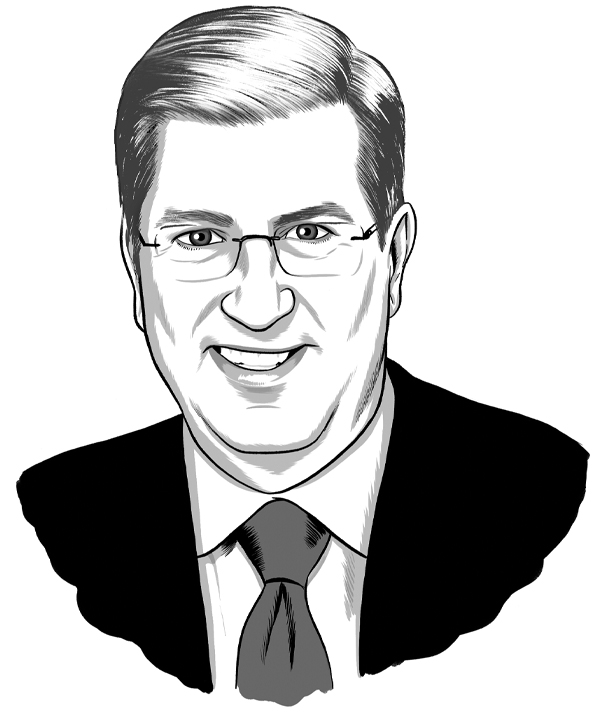
Serving the Whole Student, Today and Tomorrow
Bucknell put years of work into getting them here, too — the August arrival of the new class is the endpoint of a lengthy recruitment, application, admission and enrollment process. Our Admissions team begins communicating with prospective students as early as ninth grade to raise their awareness of Bucknell and help them discern whether we might be a good fit for their talents, interests and goals. Even as competition for students has increased among our peer institutions, we’ve been extremely successful, because we are strategic, forward-thinking and highly intentional about our future.
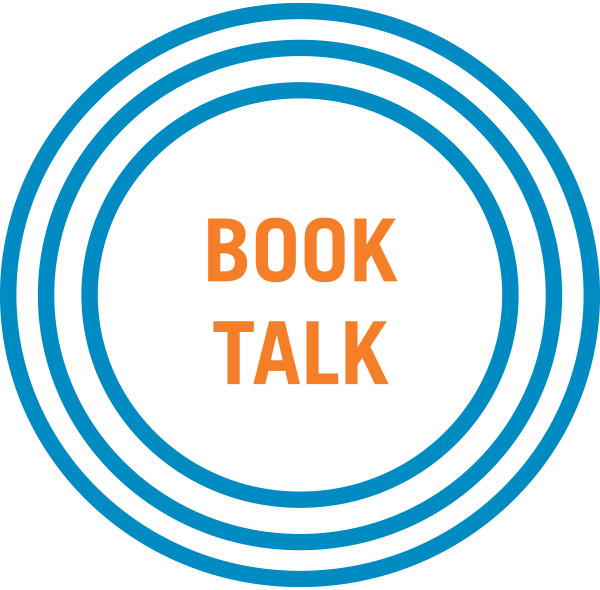

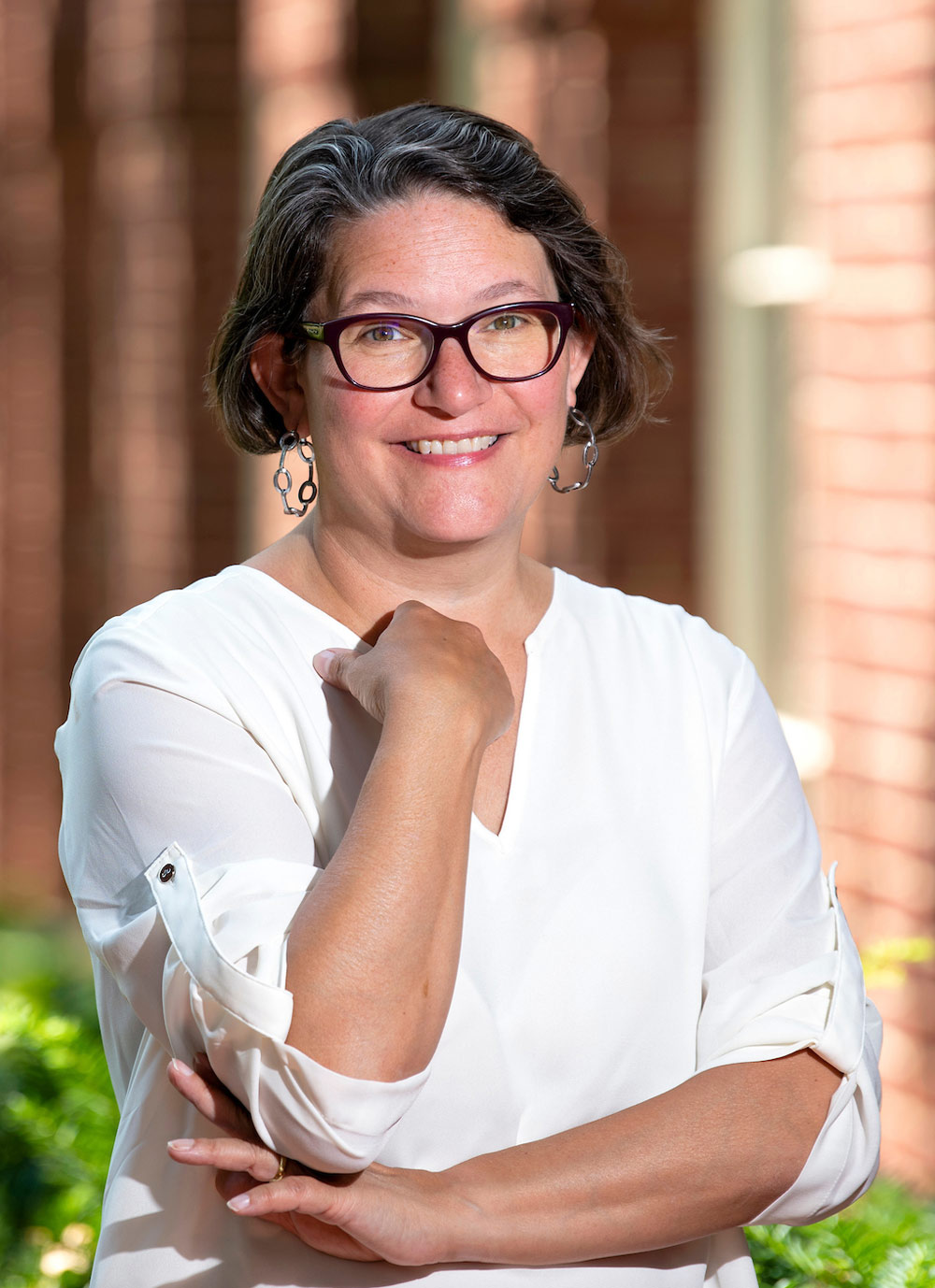





Pink: A Women’s March Story
Now, Zimmerman has captured the experience of the Women’s March on Washington in her new children’s book, Pink: A Women’s March Story. Illustrated by Mary Newell DePalma, it captures the sights and sounds of that day — the honking cars, the energy of the crowd and notable figures like Gloria Steinem speaking in the distance. And of course, the knit pink hats, worn by nearly everyone, including the narrator Lina, a little girl who looks out on the crowd from atop her father’s shoulders and feels like “one little stitch in a great big beautiful hat.”
Zimmerman, now a professor of English at Bucknell, grew up in Northern Virginia, “in the shadow of government,” and even as a young child was aware of marches, protests and civic action in nearby D.C. Moreover, her mother was a volunteer poll worker who participated in groups like the League of Women Voters. As a result, Zimmerman grew up with the idea that “you have a voice and a role to play with civic responsibility and protest.”
The gifts of Bertrand Society members strengthen every facet of the University.
Mary Beard ’84
Kurt Gebauer ’73
James R. ’66, M’68 and Susan M. Sanders ’68
Miriam Starr ’73
(1 anonymous)
Lawrence S. Bloom ’52
Carolyn Melick Derr ’49
Ira T. Ellis Jr. ’56
Dorothy Zebrowski Goodman ’68
F. Ellis Harley ’59
Terry J. Hibbard ’71
Richard Layman ’65
Ruth Castner Rusling ’52
Leanne Freas Trout ’50
Charles M. Vosburg ’58
Mary Beard ’84
Kurt Gebauer ’73
James R. ’66, M’68 and Susan M. Sanders ’68
Miriam Starr ’73
(1 anonymous)
We celebrate the legacy gifts made by members no longer with us:
Lawrence S. Bloom ’52
Carolyn Melick Derr ’49
Ira T. Ellis Jr. ’56
Dorothy Zebrowski Goodman ’68
F. Ellis Harley ’59
Terry J. Hibbard ’71
Richard Layman ’65
Ruth Castner Rusling ’52
Leanne Freas Trout ’50
Charles M. Vosburg ’58
Community Builder
Walker grew up in the small mining town of Bigler, home of the Bradford Coal Company his father started in 1935. As is common in rural Pennsylvania, the tight-knit community was full of neighbors who knew each other by name, shared common values and took a communal approach to raising children.
But like many mining villages, the town fell upon hard times when factories closed and industry left.


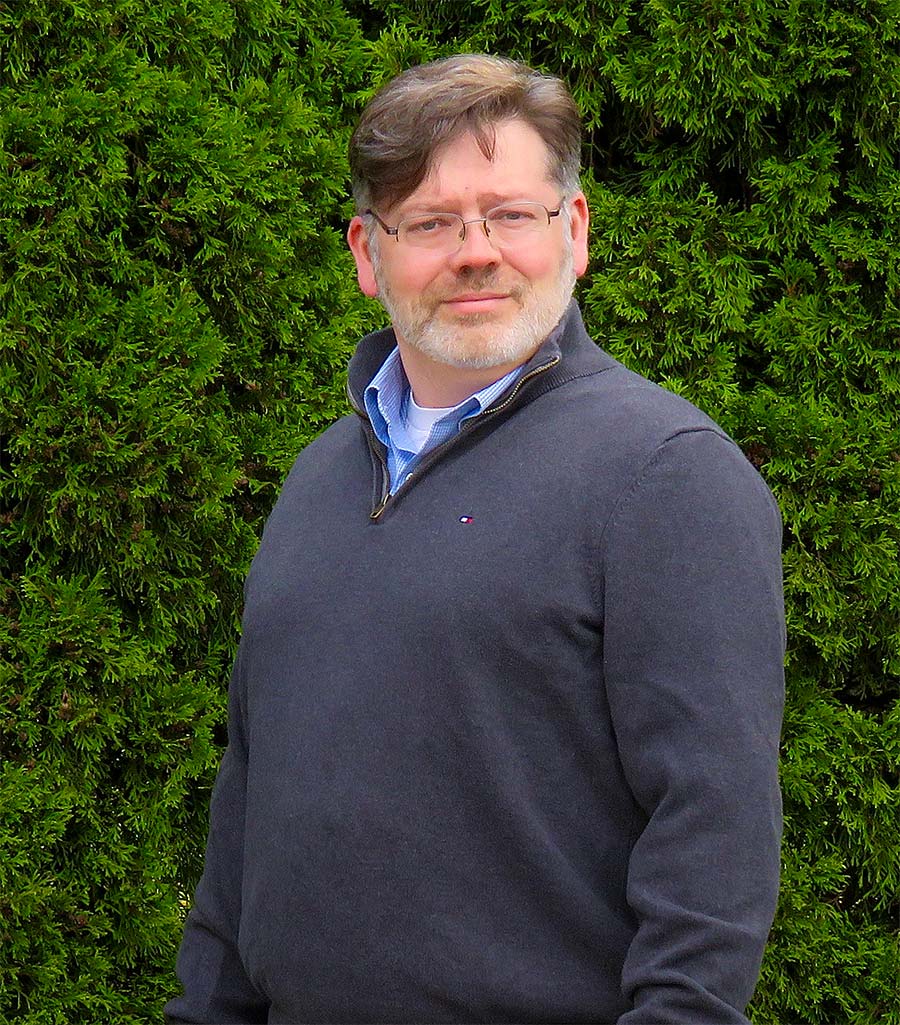
Discovery Machine
by Katie Williard
Discovery Machine, based in Williamsport, Pa., grew from sleepless nights and a Small Business Innovation Research Grant from the Defense Advanced Research Projects Agency (DARPA). “Using the power of artificial intelligence (AI), we create interactive cognitive training agents,” Griffith says. “But we know that not all expertise can be captured in data.” Using a hybrid approach, Griffith’s company combines interrogable AI (which can be questioned and form a response) with in-person instruction.
Twenty-two years of business has resulted in a well-tested methodology that is now being used by the Air Force. “By interspersing the virtual instruction and simulations with supervised flying practice in T-6 training planes, they are able to reduce the time to the pilot’s first solo flight. What was taking nine months is now taking three,” says Griffith.
Getting Her Hands Dirty
Lisa Blazure ’91’s days are spent far from the bay, but the goal of her work with the Stroud Water Research Center focuses primarily on restoring the Chesapeake’s health. And she’s doing so right in the heart of the Pennsylvania farmlands.
“The center was founded in 1967, before the Clean Water Act,” says Blazure. “Its original focus was on understanding overall stream dynamics, but they realized the need to look beyond the stream corridor, examining how the lands in the watershed were being managed.”
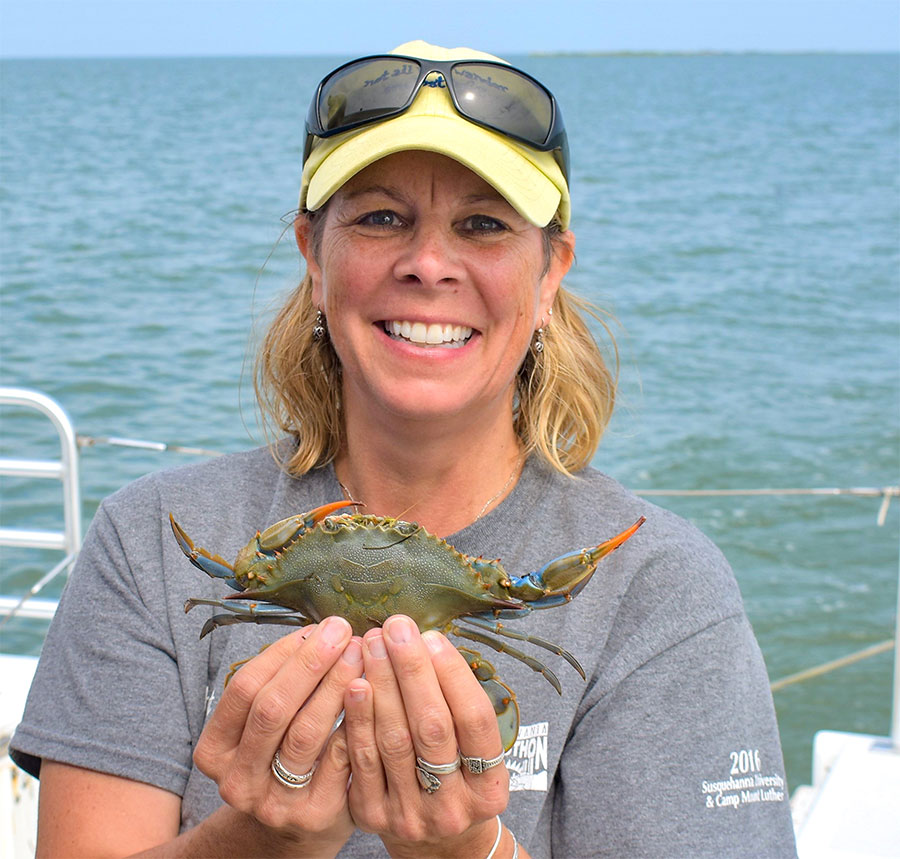
PROFILE
Parallels
With her heart set on becoming a doctor, she studied cell biology and biochemistry and minored in philosophy. Then, her interest in social justice ignited through service-learning and advocacy programs at Bucknell — namely the Bucknell Brigade.
“In my first trip to Nicaragua, we understood the sociopolitical background, health care access and the environment before we got there. So it wasn’t just a moving experience — for most of us, it was the first time we really witnessed poverty. We understood why things were the way they were and how our country played a role. That experience just really wakes you up.”
Her service work expanded. She participated in Bucknell’s Scholars in Service program with AmeriCorps on its hunger and homelessness team, spending overnights doing intake at a local shelter, and working with the team to start a soup kitchen in the community.
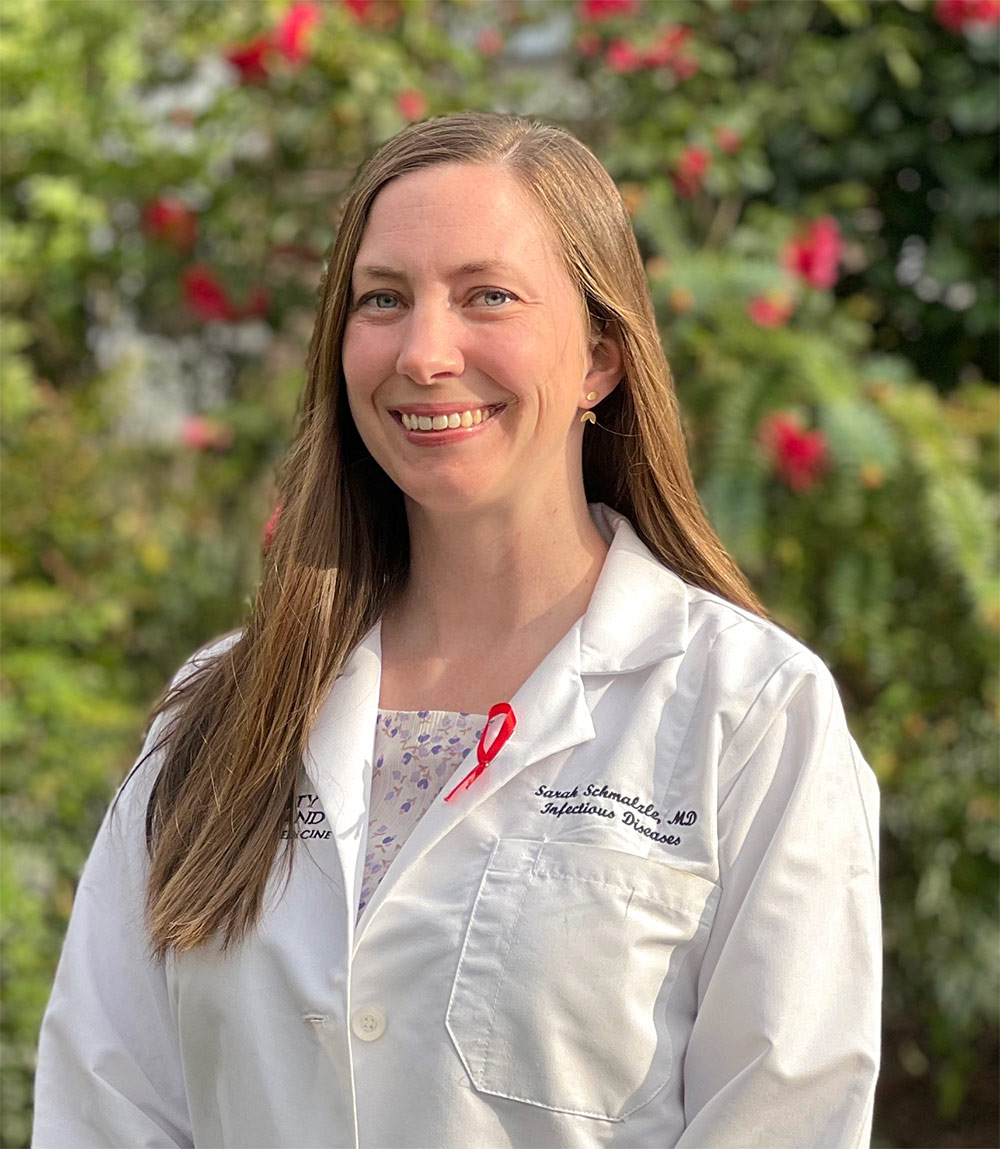
Worlds Collide
Pei helps write the code that propels the technological wizardry of the popular audio streaming service. “The code I contribute to tells the app what song to recommend to you,” he says. “We use data from content performance analytics to make your personal experience better.”
He speaks passionately about his work, but couldn’t have predicted his career path. His first love is music.
Growing up in the New York City suburbs with two musician parents, he studied violin and voice — his mother and father’s instruments. But as the only son of first-generation immigrants from China, Pei was advised by his parents to study music only if he paired it with “another versatile major.” At Bucknell, he found the opportunity to continue performing — with the Bison Chips, chorus and orchestra, as well as at open mics on campus — while double-majoring in math and economics.
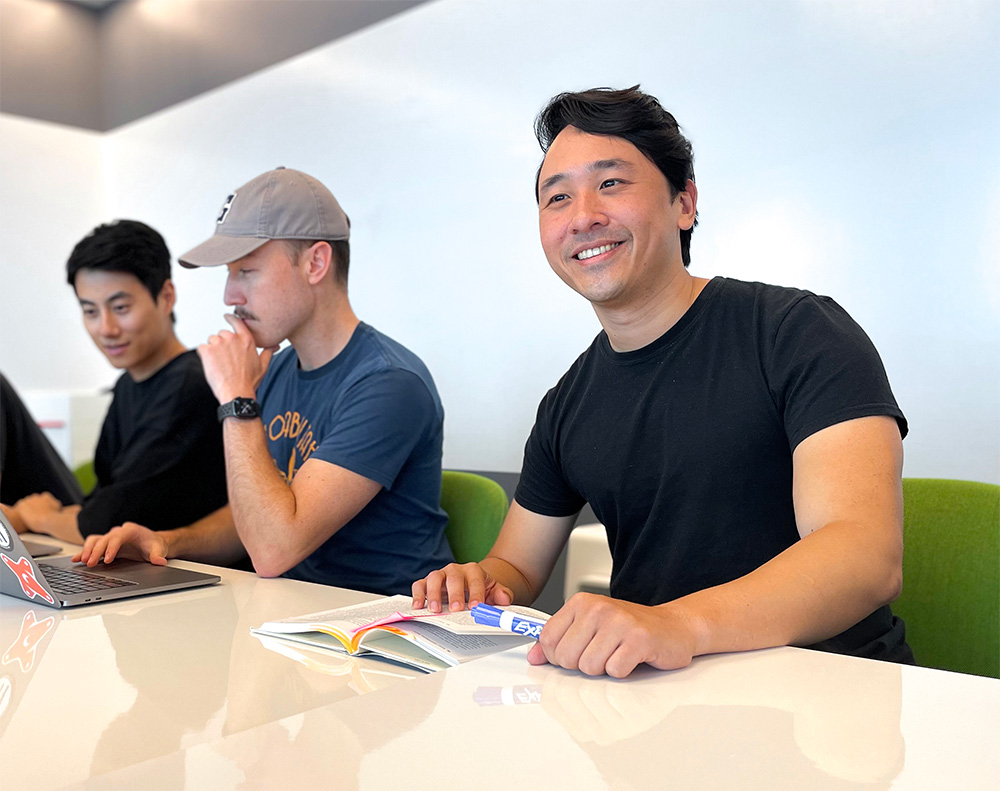
Life Out Loud
Boston.com called her “a force in the city” ahead of her May performance. Named one of NPR’s 2020 Slingshot Artists to Watch, and featured in the Boston Globe, Boston Magazine and HuffPost, Williams is an established fixture of the Boston music scene whose work combines honest, sensitive lyric writing with a mainstream rap sound. The release of her third album, Unbothered, is the culmination of the work she’s done since leaving Bucknell.

IN MEMORIAM
1936
1941
1942
1945
Bill Watkinson, May 25, Flemington, N.J.
Robert Brungraber G’05, Professor Emeritus, Civil & Environmental Engineering
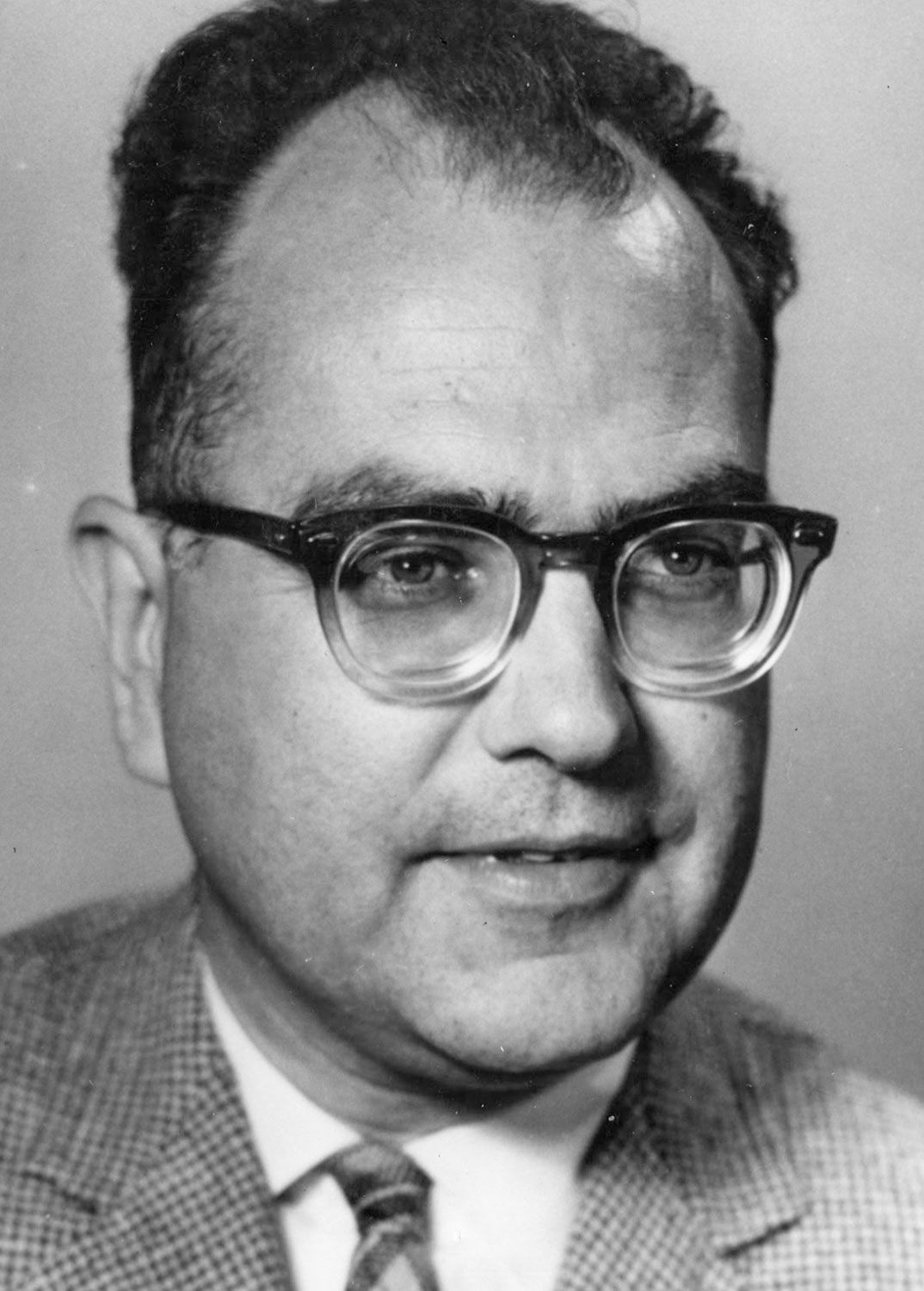
The 40th anniversary and rededication of the Hufnagle pedestrian footbridge garnered news coverage in early 2022, bringing worthy attention to Brungraber’s role in the design and building of the local landmark. (Read more about the anniversary on Page 7.)
In addition to his well-known bridge work, Brungraber also designed and supervised the construction of a campus facility to house the University’s 600,000-pound Baldwin universal testing machine, providing students a space “to learn the importance of testing connections that hold structures together.” Beginning in 1978 with the delivery of the Baldwin to campus, the professor sourced experimental materials that could be used to construct the building at little or no cost to the University, offering his consulting services in return to the companies who donated in kind. “Bob was not only an outstanding engineer, but also he was a great salesperson for Bucknell engineering,” said Professor Emeritus Jai Kim, civil engineering, who worked closely with Brungraber throughout his career. The building was completed in 1985 but stood unnamed until his retirement in 2000, when the department dedicated the Brungraber Civil Engineering Structural Test Laboratory in his honor.
At Brungraber’s retirement ceremony, former Dean of Engineering Thomas Rich spoke of the professor’s impact. “The structures testing facility symbolizes your ingenuity, perseverance, dedication and skills as both engineer and entrepreneur,” he said. “You can take pride in knowing the many students who have benefitted from your teaching and those who will benefit in future years from their experiences in the structures testing lab.”
DO
Stay Current on Crypto
Know an outstanding Bucknellian?
Stay connected!
Answer This:
FOLLOW US ON FACEBOOK TO SUBMIT YOUR ANSWER
Crowdsourced
What was your favorite animal encounter on campus?
We had a “pet” squirrel named Bert who lived outside of Trax. We’d bring him bagels and things back from the caf all the time. I eventually was able to coax him up onto my shoulder if I sat on the sidewalk really still.
When observing the snow monkeys, my partner got close to the cages and one of the monkeys came out of nowhere, snatched our records out of his hand and gave it to the alpha monkey, who proceeded to eat it. We had to go to Professor Candland and explain what happened, to which he dryly replied, “So you’re telling me that the monkey ate your homework?”
Alumni Service Recognized
Four alumni were recognized during Reunion Weekend for their contributions to the University and society with awards from the Bucknell University Alumni Association. Honored for their passion and service were:
Connie Tressler ’62, M’65, P’90, Loyalty to Bucknell Award: Tressler has remained committed to Bucknell and the surrounding community since her graduation, serving as president of the Bucknell Club of the Greater Susquehanna Valley and the Bucknell Club of Northeastern Pa. As a member of the Bucknell Public Interest Program, she has helped match students seeking opportunities in the nonprofit and public service sectors with employers. She was also a volunteer for her 50th and 55th Reunion Giving Committee and chair for her 55th and 60th Reunions.
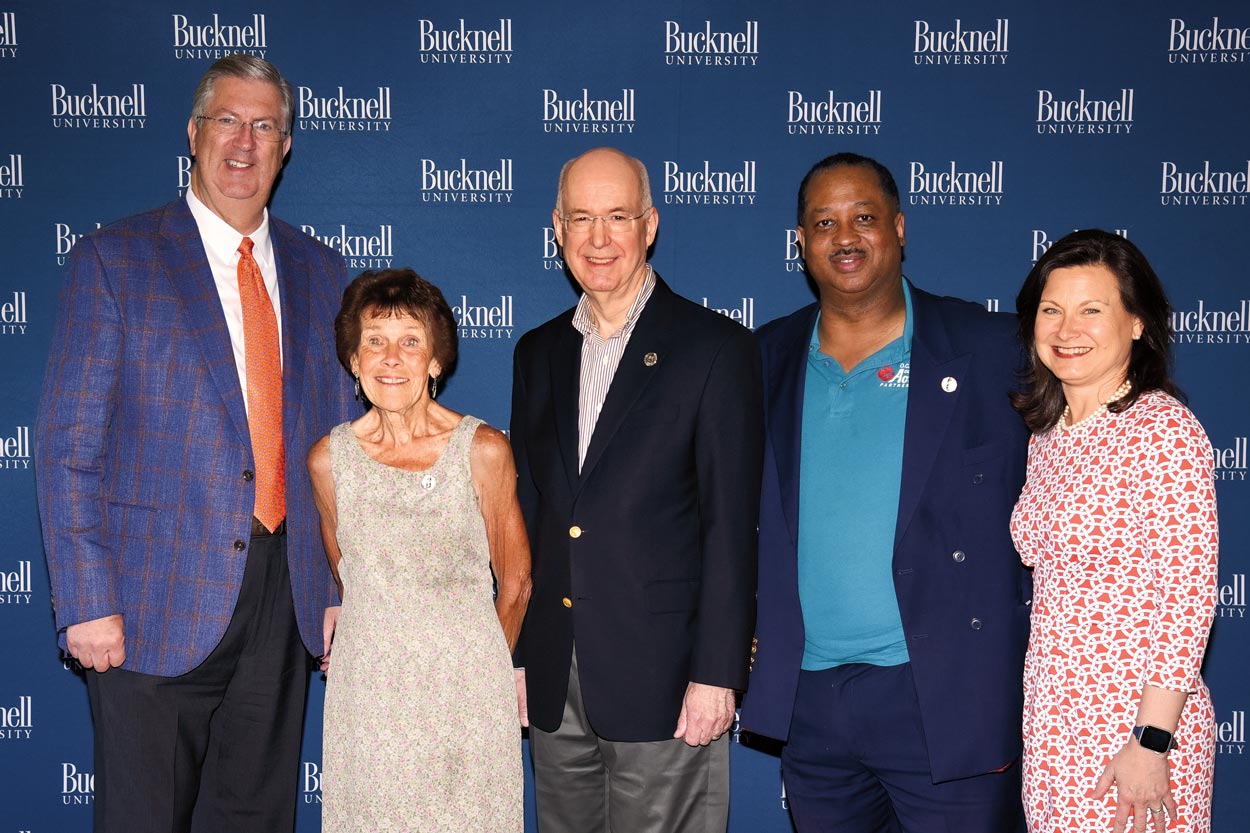
From left: President John Bravman, Tressler, Freeman, Wilkins and Bucknell University Alumni Association President Christine Zapotocky Kelleher ’91 during the Reunion awards ceremony.
Lisa H. Tostanoski ’12, Young Alumni Award: Tostanoski is a postdoctoral fellow in the Center for Virology and Vaccine Research at Beth Israel Deaconess Medical Center – Harvard Medical School. Since graduating from Bucknell, she has pursued academic research training, developing expertise in biomaterials, drug delivery, vaccine design and immunology. She has published over 40 peer-reviewed articles in journals such as Nature, Cell, Science and the Journal of the American Medical Association (JAMA).
Kenneth W. Freeman ’72, Outstanding Achievement in a Chosen Profession Award: The namesake of the Freeman College of Management and the Kenneth W. Freeman Professorship and Dean of Management position, Freeman was a Bucknell trustee for 18 years and chair of the board for nine. He began his career at Corning and went on to leadership roles in numerous organizations. Notably, he served as chairman, president and CEO of Quest Diagnostics and later as dean of the Questrom School of Business at Boston University.
Share a Mod Memory
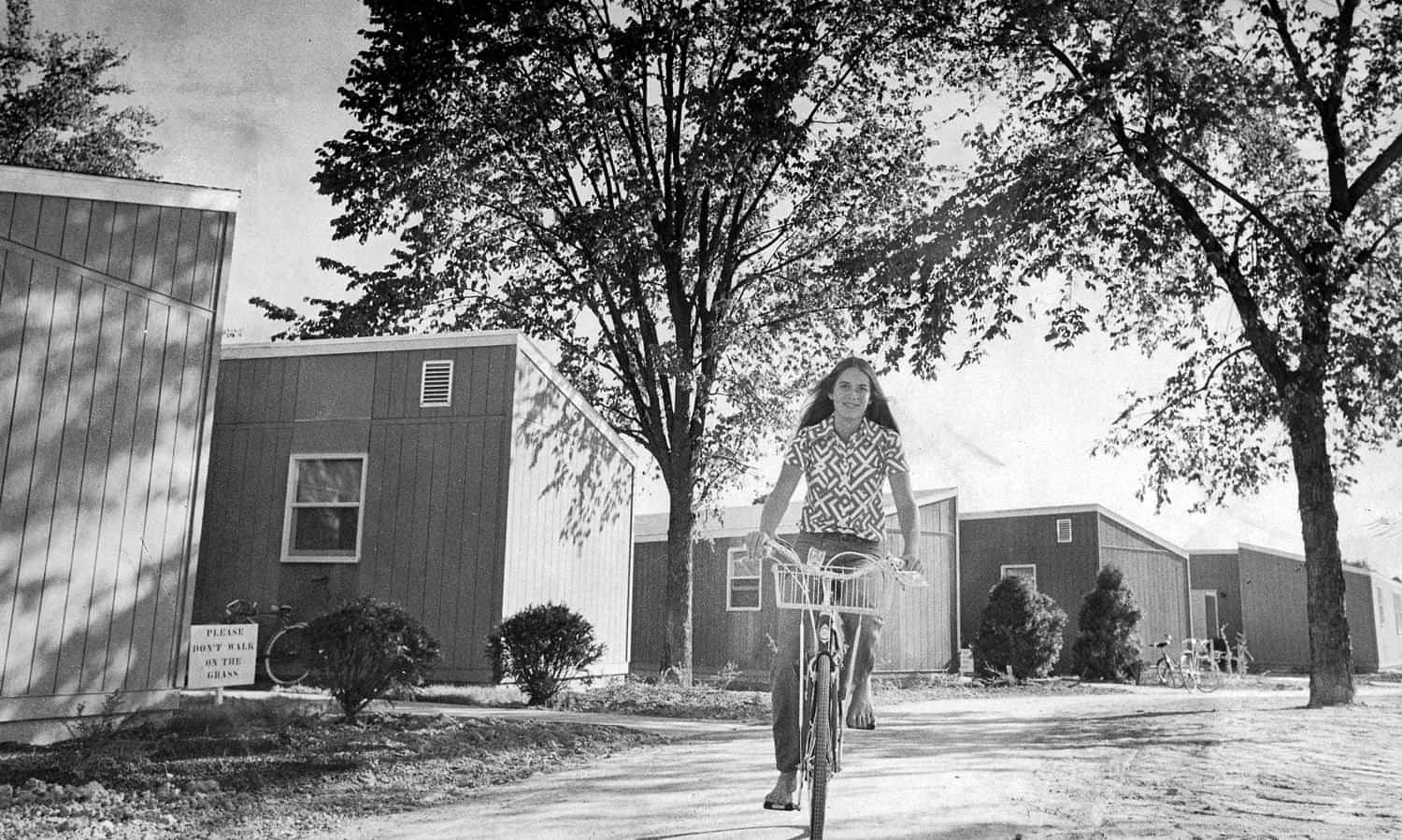
Photo: Special Collections/University Archives/Greg Moyer
After a half century, Bucknell’s “temporary” housing units, the Mods, are being replaced. Before they’re gone, we want to hear your Mod memories. Responses may appear in a future magazine issue.

bmagazine@bucknell.edu
INSPIRING YOUNG MINDS
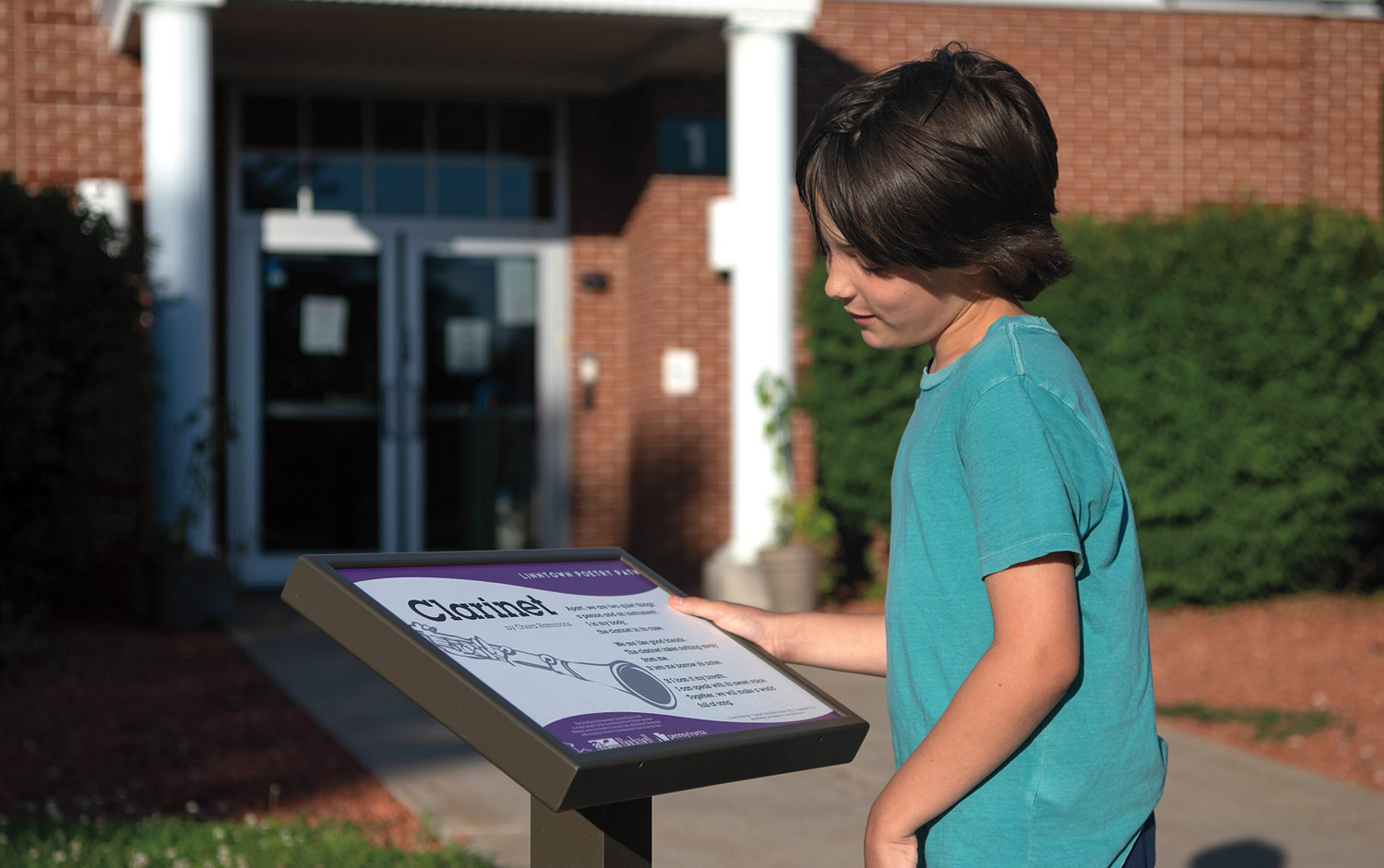
Isa Lamparter, 10, a student at Linntown Intermediate School, reads a poem on the poetry path.
Furthering its effort to bring the power of poetry to the public, Bucknell’s Stadler Center for Poetry & Literary Arts recently installed a new poetry path on the grounds of Linntown Intermediate School, just outside Lewisburg.
Funded by the Pennsylvania Council on the Arts, the path includes six stops at locations students frequent throughout the day, each featuring a children’s poem selected by the Linntown student body.
“We hope that the path will help show school-age children the artistic potential of language,” says Stadler Center Program Manager Andrew Ciotola.
Witty Winners
“Relaxing after ‘acing’ their finals. It’s hard to beat four of a kind.”

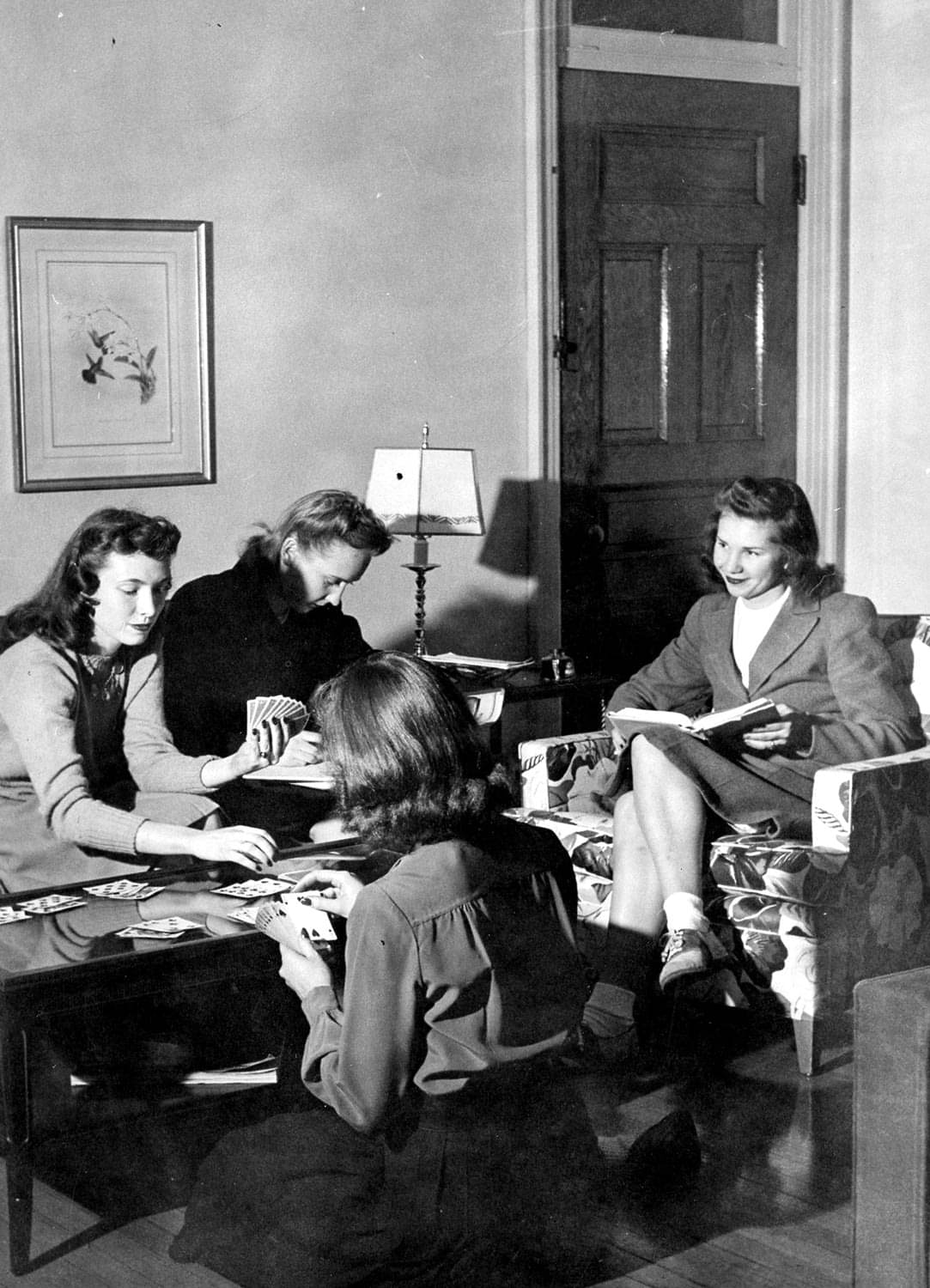
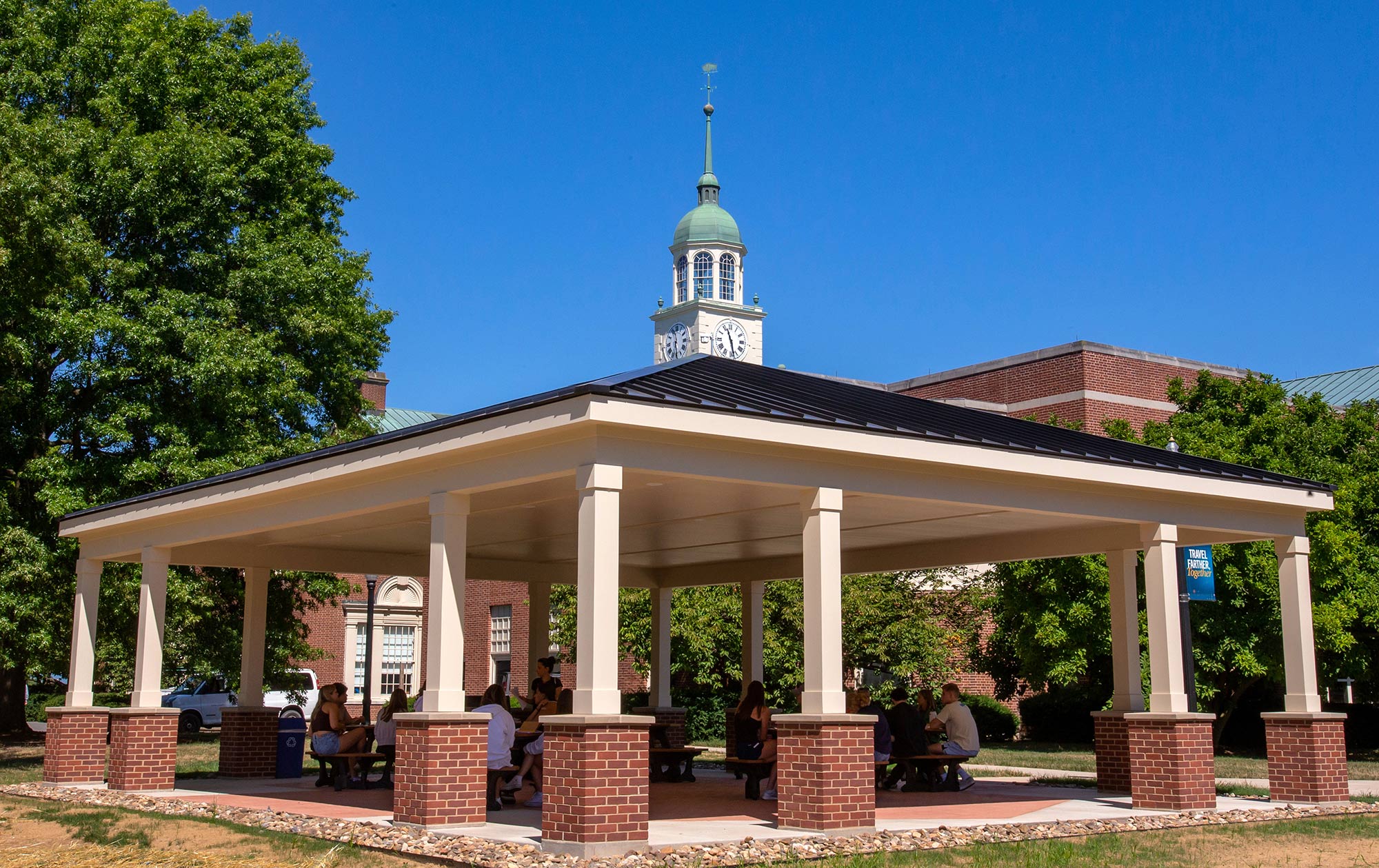
Enjoy the Shade
 New pavilions are a popular spot for gathering, study and more
New pavilions are a popular spot for gathering, study and moreEnjoy the Shade
 New pavilions are a popular spot for gathering, study and more
New pavilions are a popular spot for gathering, study and moreWhen Bucknell’s Facilities division began raising tents around campus in preparation for the return of in-person classes in fall 2020, the first thought on the minds of most was certainly not, “People are going to love these.”
But according to Justin Salyards, project manager for Facilities, over the two years that followed many at Bucknell gained an affinity for the white big tops protruding from among the cherry trees and collegiate Georgian buildings.
Even after vaccines and other safety protocols reduced their necessity, faculty appreciated the option of a shady space to teach on a beautiful central Pennsylvania day. Students likewise took a liking to the room to study, hold club meetings or just enjoy the beauty of Bucknell’s campus in the cool shade that the tents afforded. The fondness extended to the very top: “It was actually President Bravman who asked, ‘Can we make some of these permanent?’ ” Salyards says.
Back Cover
photograph by DOUGLAS KILPATRICK
Back Cover
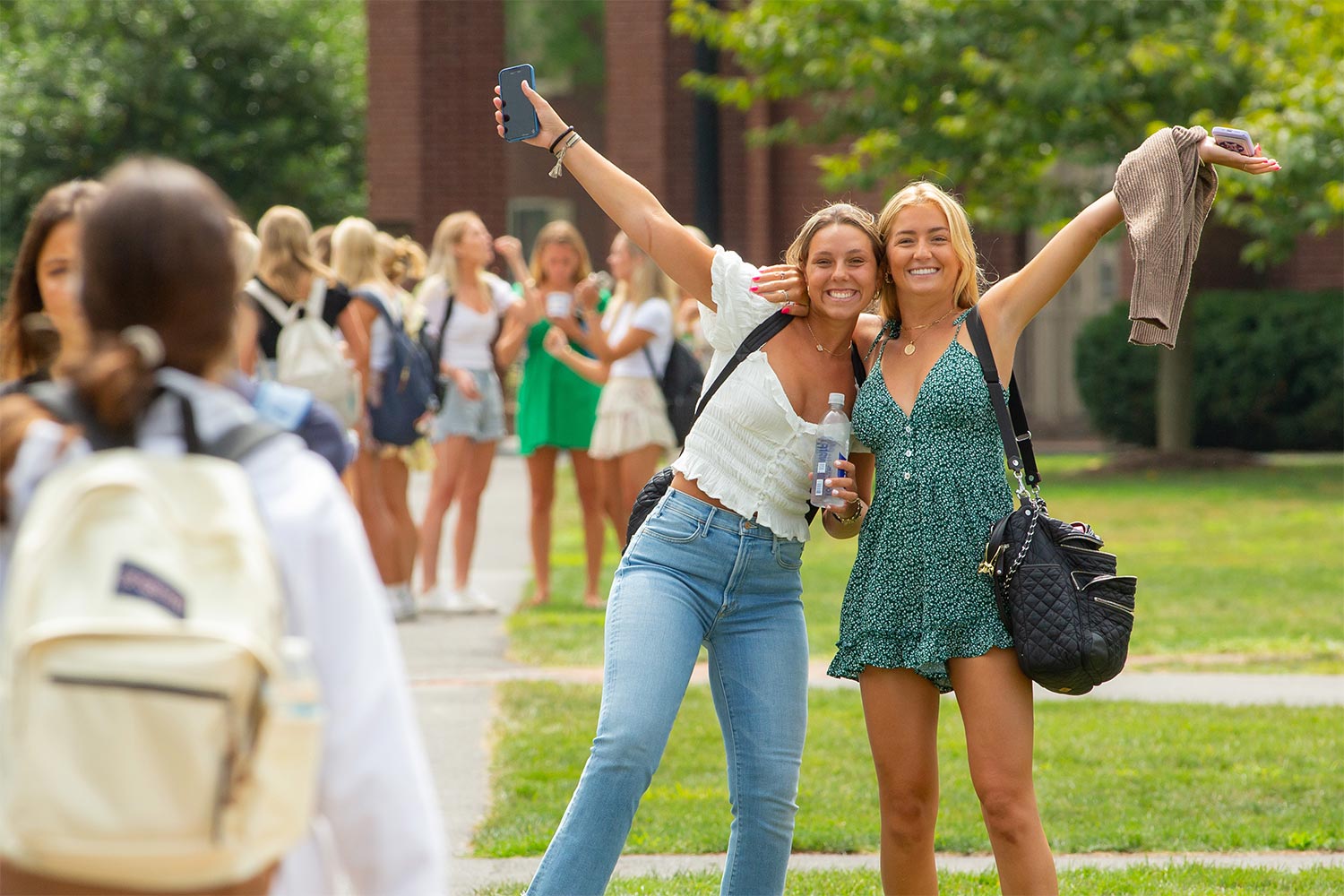
photograph by DOUGLAS KILPATRICK

